Synology at Computex 2025 – New NAS, Flash, and Surveillance Solutions Unveiled
At Computex 2025, Synology unveiled an extensive range of new hardware and storage solutions across both consumer and enterprise tiers. From compact desktop NAS to high-performance rackmount flash storage systems, the 2025 product line spans diverse use cases in home multimedia, business backups, AI-powered surveillance, and parallel active storage infrastructure. However, a significant underlying theme across this year’s announcements is Synology’s strict enforcement of Synology-verified storage media across both the Plus series and enterprise-class devices.
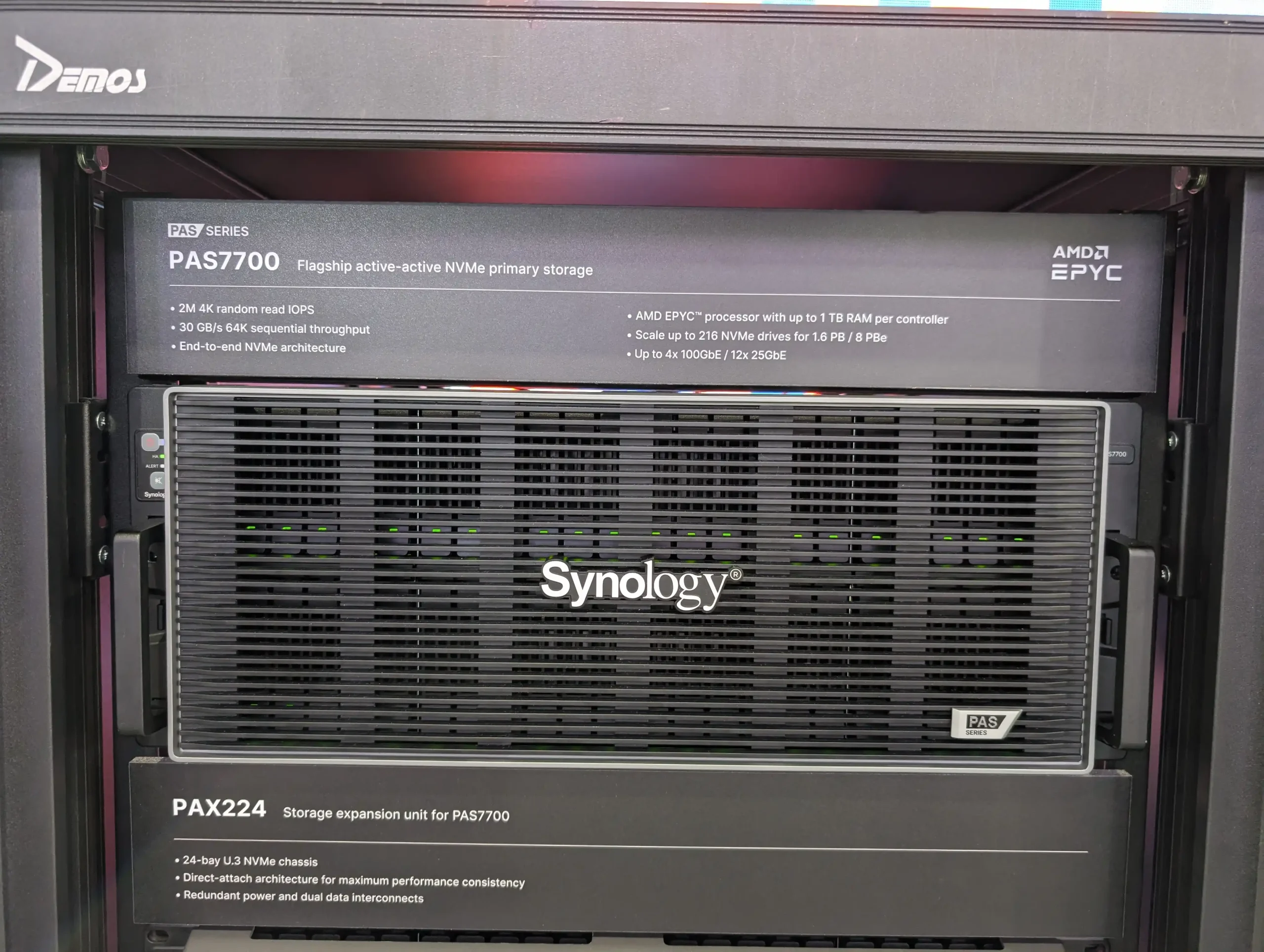 This ongoing shift in policy has raised concerns within the NAS community—especially among users who rely on third-party drives for flexibility and cost-effectiveness. Messaging around this storage validation system remains inconsistent, with key technical and strategic details still unclear. Nonetheless, this year’s lineup confirms Synology’s intent to consolidate hardware and media under its own ecosystem, even while expanding its presence into flash-first infrastructure and turnkey surveillance platforms.
This ongoing shift in policy has raised concerns within the NAS community—especially among users who rely on third-party drives for flexibility and cost-effectiveness. Messaging around this storage validation system remains inconsistent, with key technical and strategic details still unclear. Nonetheless, this year’s lineup confirms Synology’s intent to consolidate hardware and media under its own ecosystem, even while expanding its presence into flash-first infrastructure and turnkey surveillance platforms.
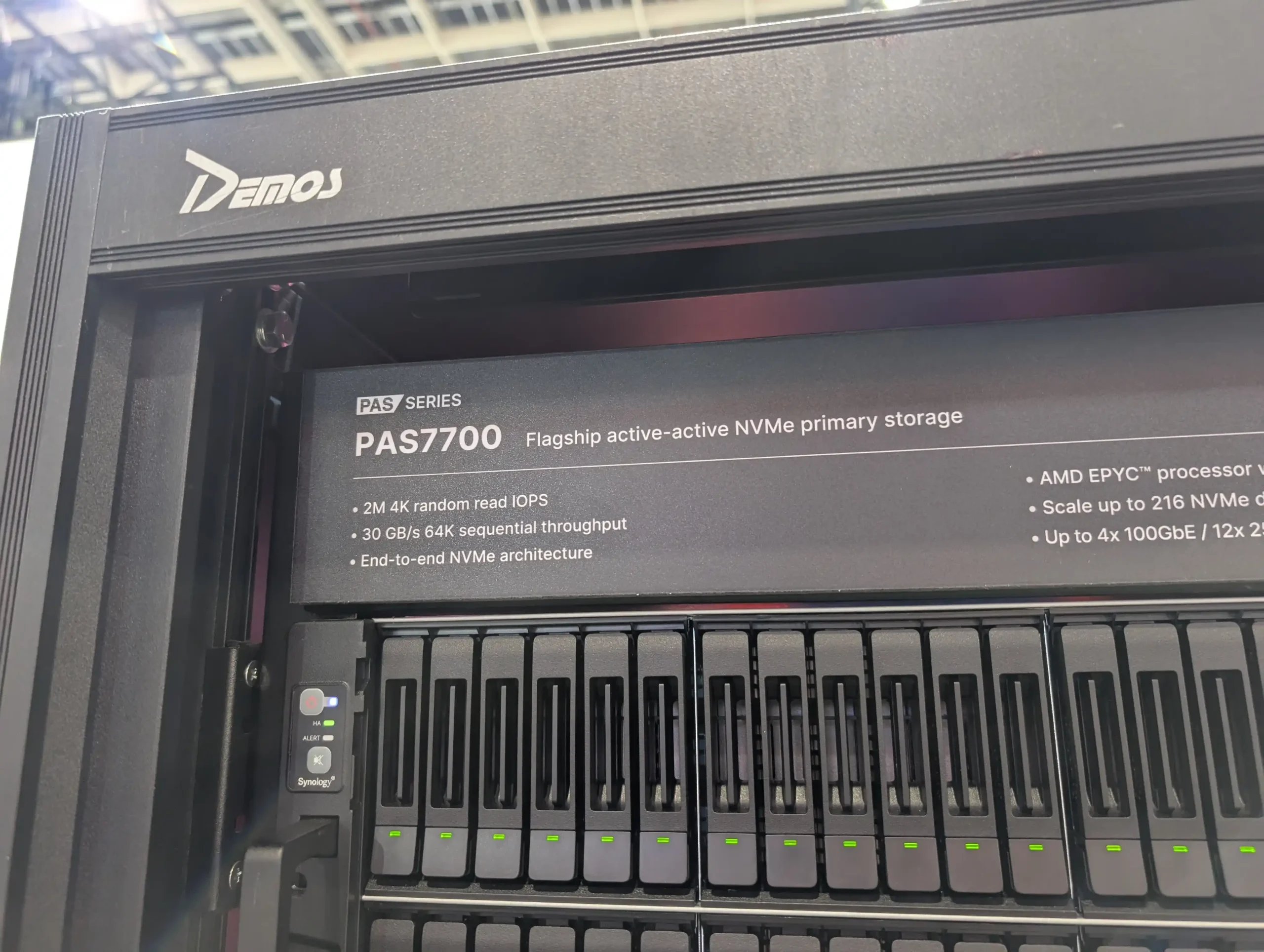
PAS7700 – Flagship NVMe Enterprise Rackmount Storage
The PAS7700 marks Synology’s formal entry into high-performance all-NVMe storage for the enterprise sector. It is the most powerful product in the new Parallel Active Storage (PAS) series, designed with a dual-controller architecture and full end-to-end U.3 NVMe support. Each controller in the PAS7700 is powered by an AMD EPYC processor, supports up to 1TB of DDR4 ECC memory, and is capable of sustaining 30GB/s sequential throughput with over 2 million 4K random read IOPS. This architecture supports true active-active failover, high concurrency, and data consistency across large virtualized workloads or AI/ML pipelines.
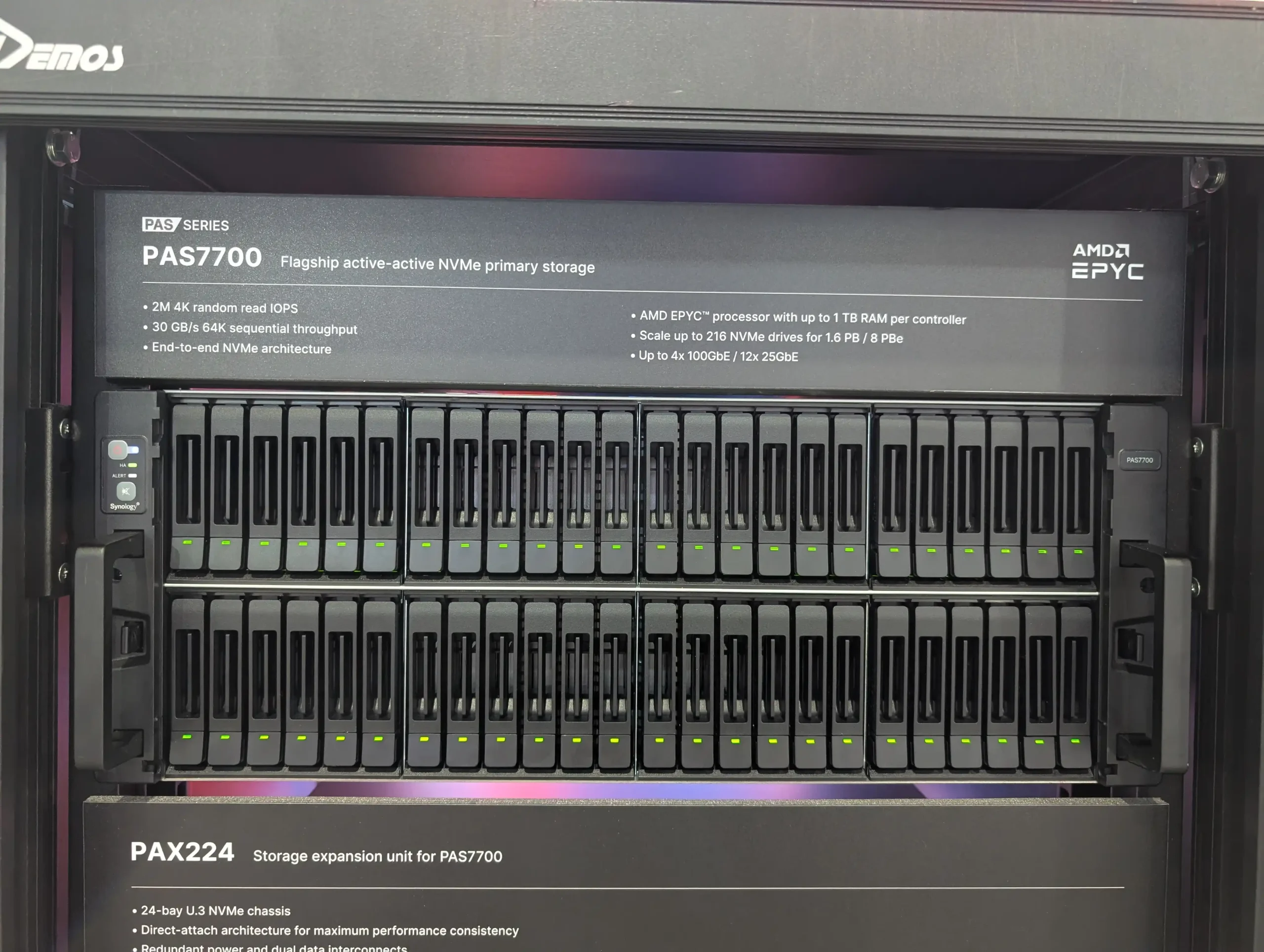
Networking options include up to 4x 100GbE and 12x 25GbE ports (via optional NICs), and expansion is achieved using the PAX224, a 24-bay U.3 NVMe expansion chassis connected via HD-SAS 12Gb/s dual-link architecture. The PAS7700’s chassis is built to scale up to 216 NVMe drives for a maximum raw capacity exceeding 1.6PB, though real-world capacity will depend on drive model, RAID configuration, and overhead.
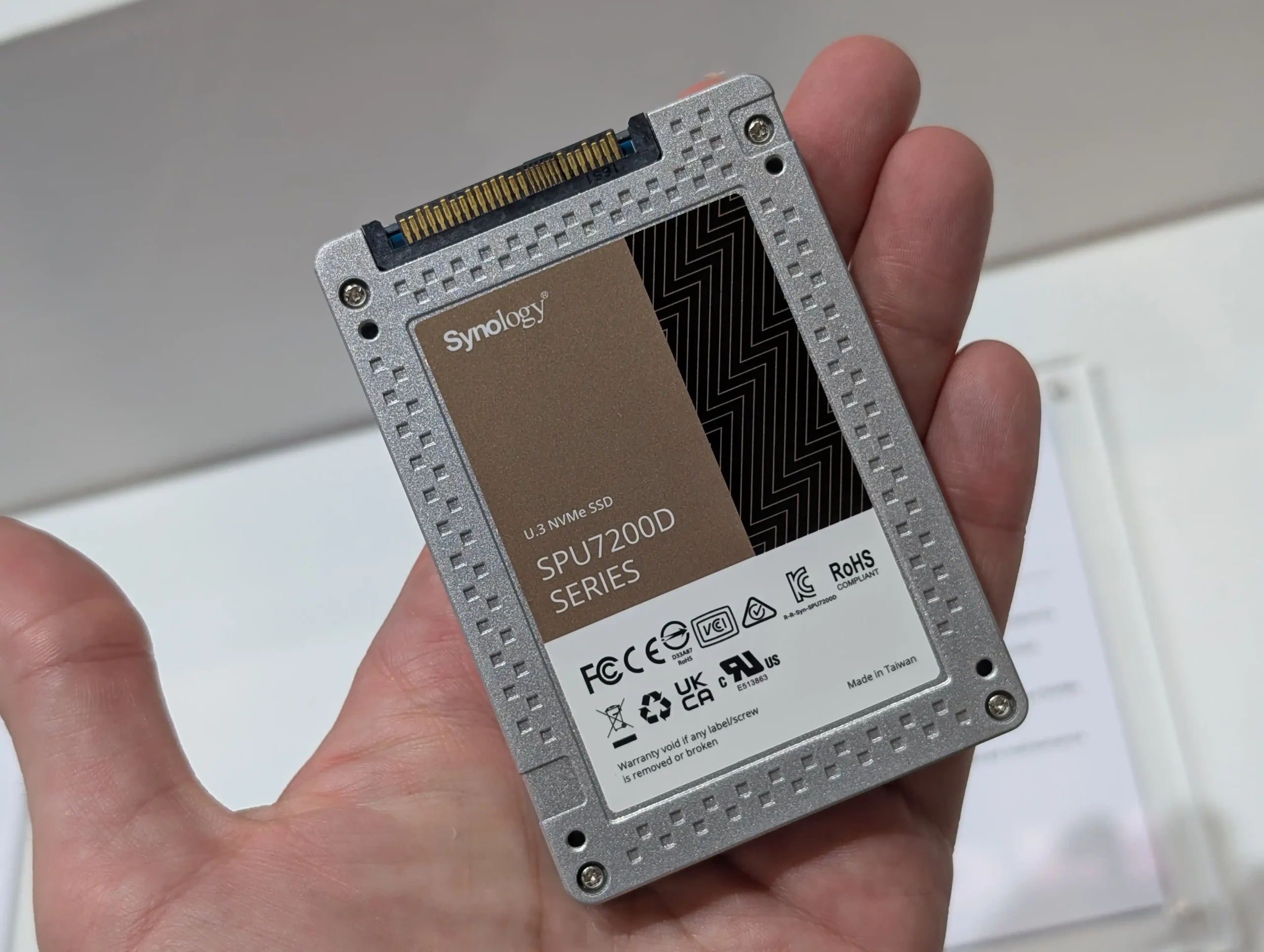
One of the more contentious elements is that, like all of Synology’s 2025 enterprise lineup, the PAS7700 mandates the use of Synology-verified U.3 NVMe SSDs. The drives shown on the show floor included 8TB Synology-branded U.3 SSDs, though Synology did not confirm their OEM origin, controller model, or endurance ratings beyond stating that they were optimized for sustained IOPS workloads. This storage lock-in policy has drawn criticism from users seeking flexibility in enterprise deployments.
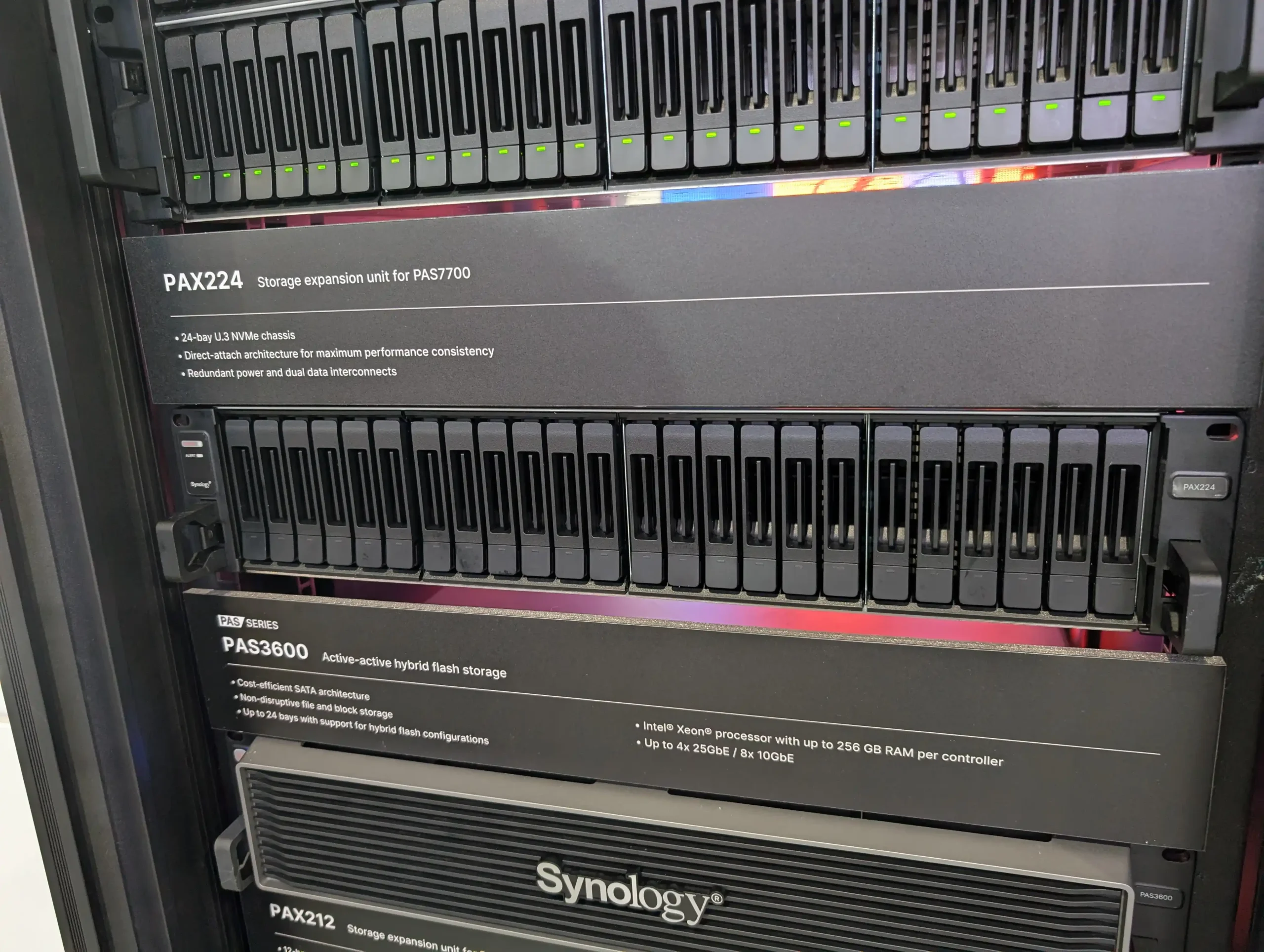
PAS7700 Specifications
| Feature | Details |
|---|---|
| Architecture | Dual-controller, active-active |
| CPU | AMD EPYC (per controller) |
| Memory | Up to 1TB DDR4 ECC (per controller) |
| Storage Bays | Native U.3 NVMe (up to 216 drives w/ expansion) |
| Max Sequential Throughput | 30GB/s (64K read/write) |
| Max 4K Random Read IOPS | 2M+ |
| Network Interface Options | Up to 4x 100GbE, 12x 25GbE |
| Expansion | PAX224 – 24-bay U.3 NVMe (HD-SAS 12Gb/s) |
| Media Compatibility | Synology-verified U.3 NVMe SSDs only |
| Use Case | Tier-0 storage, virtualization, high-IOP workloads |
PAS3600 – Hybrid Flash Storage for Cost-Efficient Deployment
Positioned as the mid-range sibling to the PAS7700, the PAS3600 provides a more accessible entry into the Parallel Active Storage series by utilizing SATA drives rather than U.3 NVMe. Designed for hybrid flash deployment, the PAS3600 features dual controllers, each running an Intel Xeon processor and supporting up to 256GB of ECC DDR4 memory per controller. While it doesn’t match the raw performance of the PAS7700, it still delivers substantial throughput and redundancy suitable for enterprise virtual machine hosting, storage tiering, and backup environments.
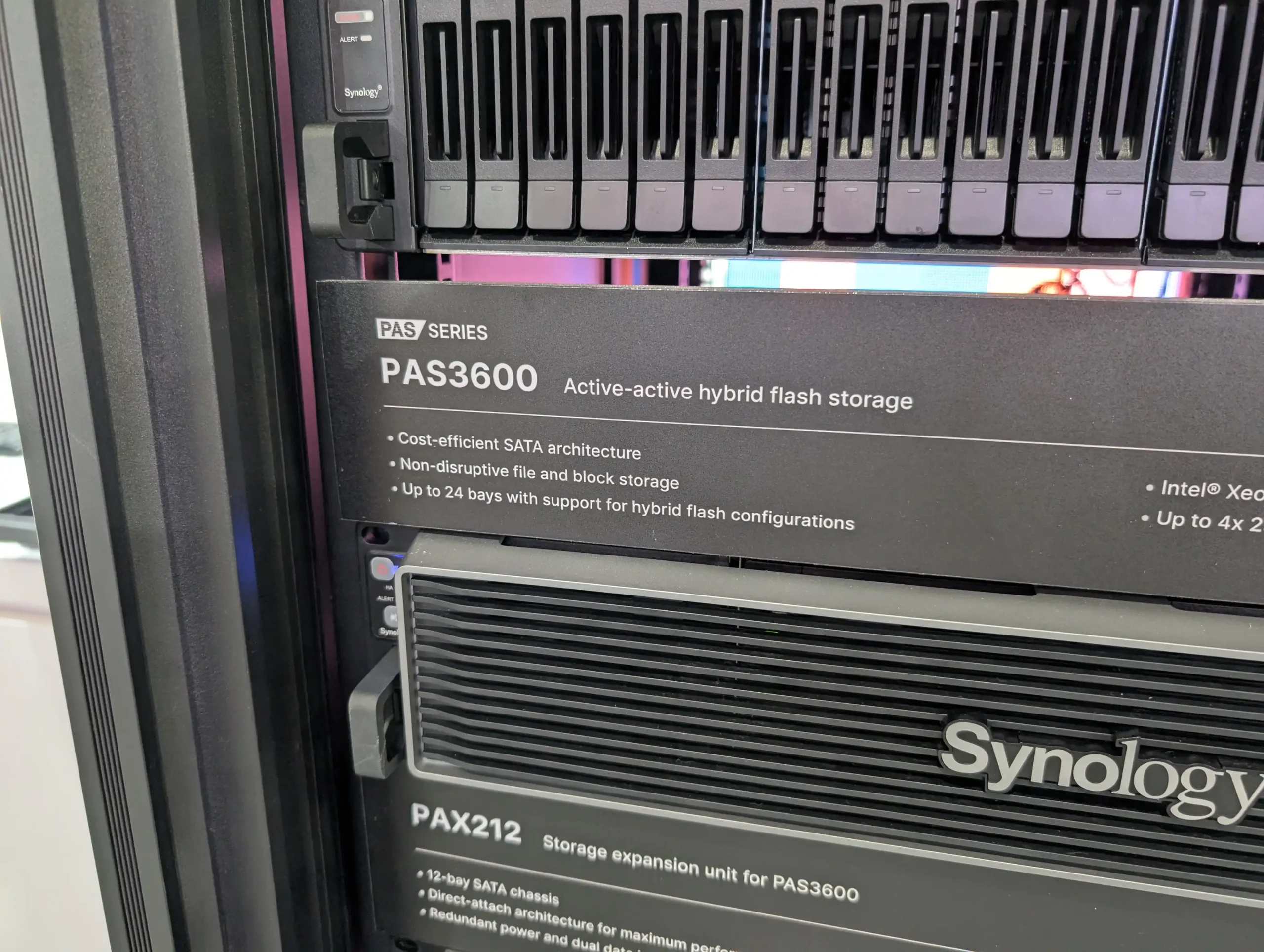
Network connectivity includes support for up to 4x 25GbE and 8x 10GbE ports via optional NICs, with the system capable of scaling out using the PAX212, a 12-bay SATA flash expansion chassis. These expansion units also use 12Gb/s HD-SAS, and maintain redundant power supplies and dual data interconnects to ensure performance stability and non-disruptive scaling. Like the rest of Synology’s 2025 enterprise systems, the PAS3600 enforces the use of Synology-verified SATA SSDs, understandable in this sector of the industry and in line with this kind fo product.

PAS3600 Specifications
| Feature | Details |
|---|---|
| Architecture | Dual-controller, active-active |
| CPU | Intel Xeon (per controller) |
| Memory | Up to 256GB DDR4 ECC (per controller) |
| Storage Bays | Up to 25 SATA bays (hybrid flash configurations) |
| Max Network Interface Options | Up to 4x 25GbE, 8x 10GbE |
| Expansion | PAX212 – 12-bay SATA (HD-SAS 12Gb/s) |
| Media Compatibility | Synology-verified SATA SSDs only |
| Use Case | Backup, hybrid flash storage, cost-optimized VM use |
DVA7400 – AI-Powered Surveillance Rackmount System
The DVA7400 represents the most powerful surveillance solution Synology has introduced to date. It is the first in the DVA (Deep Video Analytics) lineup to be available in a rackmount form factor, making it suitable for larger, centralized surveillance deployments. The unit leverages an AMD Ryzen processor in combination with a dedicated GPU, enabling support for up to 100 camera streams and 40 simultaneous AI video analysis tasks, such as motion detection, facial recognition, and people counting.
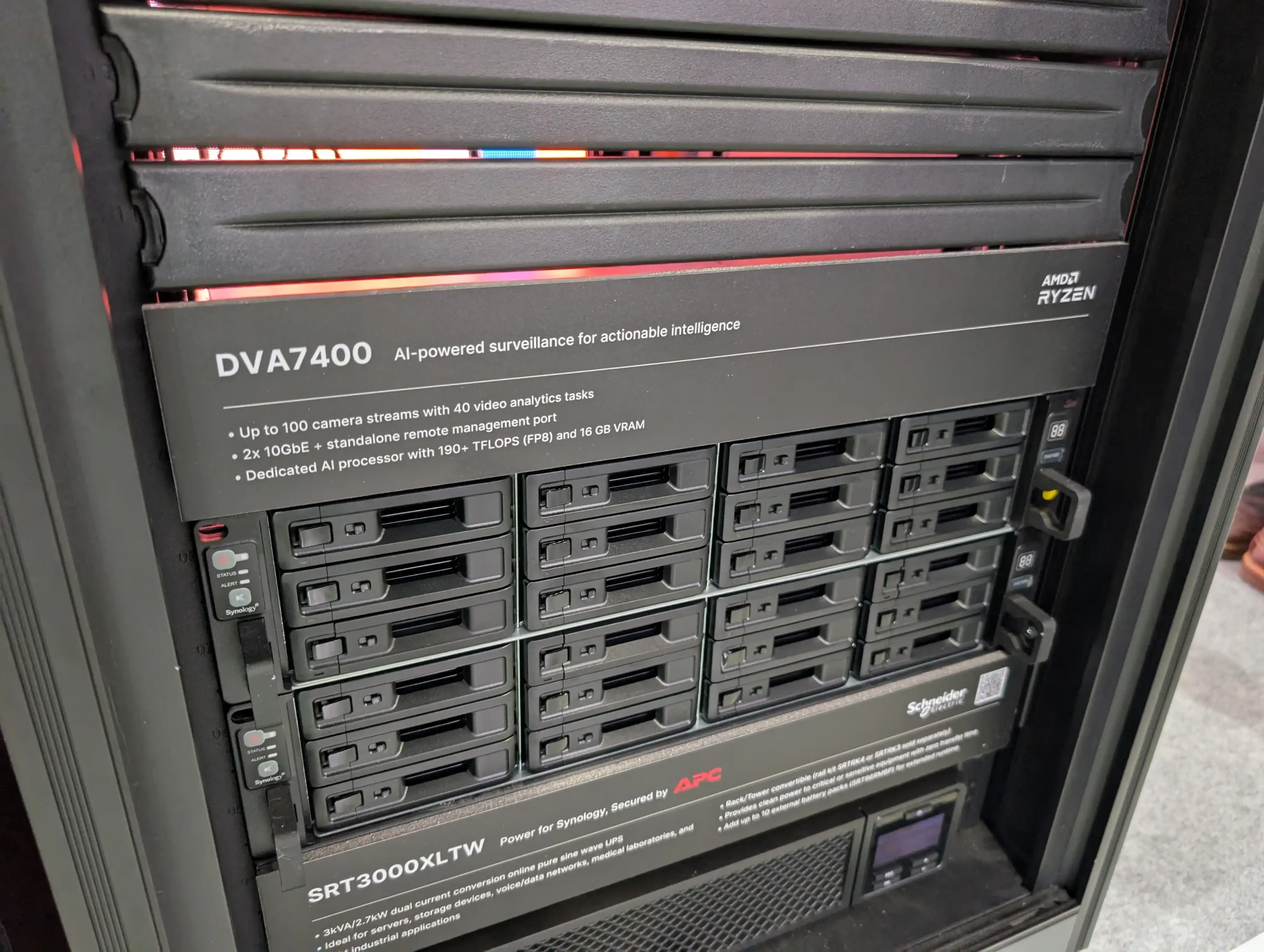
In terms of connectivity, the DVA7400 includes dual 10GbE ports to ensure adequate bandwidth for high-resolution video ingestion and management. Additionally, it features a separate remote management interface, streamlining system oversight in enterprise environments. Internally, the system includes a dedicated AI processor with 190+ TFLOPS FP8 performance and 16GB of VRAM, allowing for real-time video indexing and recognition tasks.
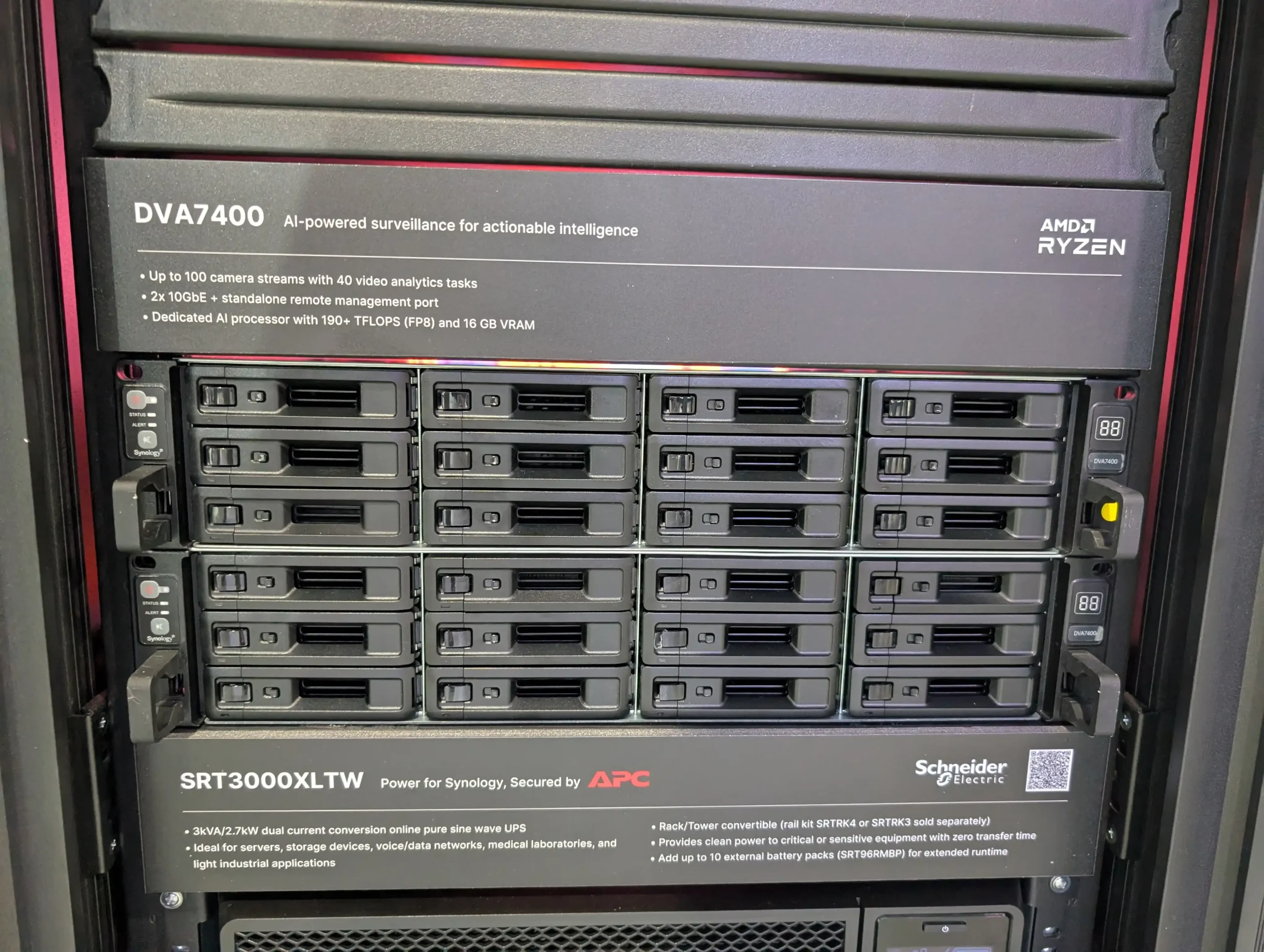
As with most Synology surveillance systems, the DVA7400 includes a limited number of camera licenses by default. However, users deploying Synology-branded cameras benefit from license-free operation. Support for ONVIF-compliant third-party cameras is included but requires standard Synology Surveillance Station licenses. While the hardware is a significant leap forward, the system’s drive compatibility remains subject questionable, as the brand does not currently have an inhouse branded surveillance optimized HDD (eg comparable to WD Purple or Seagate Skyhawk – designed for much heavier WRITE over READ).
DVA7400 Specifications
| Feature | Details |
|---|---|
| Form Factor | Rackmount (1U or 2U, TBD) |
| CPU | AMD Ryzen (model not disclosed) |
| GPU | Dedicated AI GPU (16GB VRAM, 190+ TFLOPS FP8) |
| AI Video Analytics | 40 tasks simultaneously |
| Camera Streams Supported | Up to 100 |
| Network Ports | 2x 10GbE, 1x dedicated remote management port |
| Camera License Policy | ONVIF supported; Synology cameras license-free |
| Media Compatibility | Synology-verified storage media required |
| Use Case | Enterprise surveillance, AI-driven video analysis |
FS200T – Compact All-Flash NAS for Quiet Environments
The FS200T, formerly expected as the DS625Slim, is now reclassified under the FlashStation series. This compact 6-bay NAS is designed for SSD-only deployments using 2.5″ SATA drives, and is aimed at users needing high-speed, low-noise storage in home studios or small office environments. Internally, it is powered by the Intel Celeron J4125, a quad-core processor that, while dated, includes integrated graphics. It is paired with 4GB of DDR4 memory, which is not ECC and may limit enterprise use.
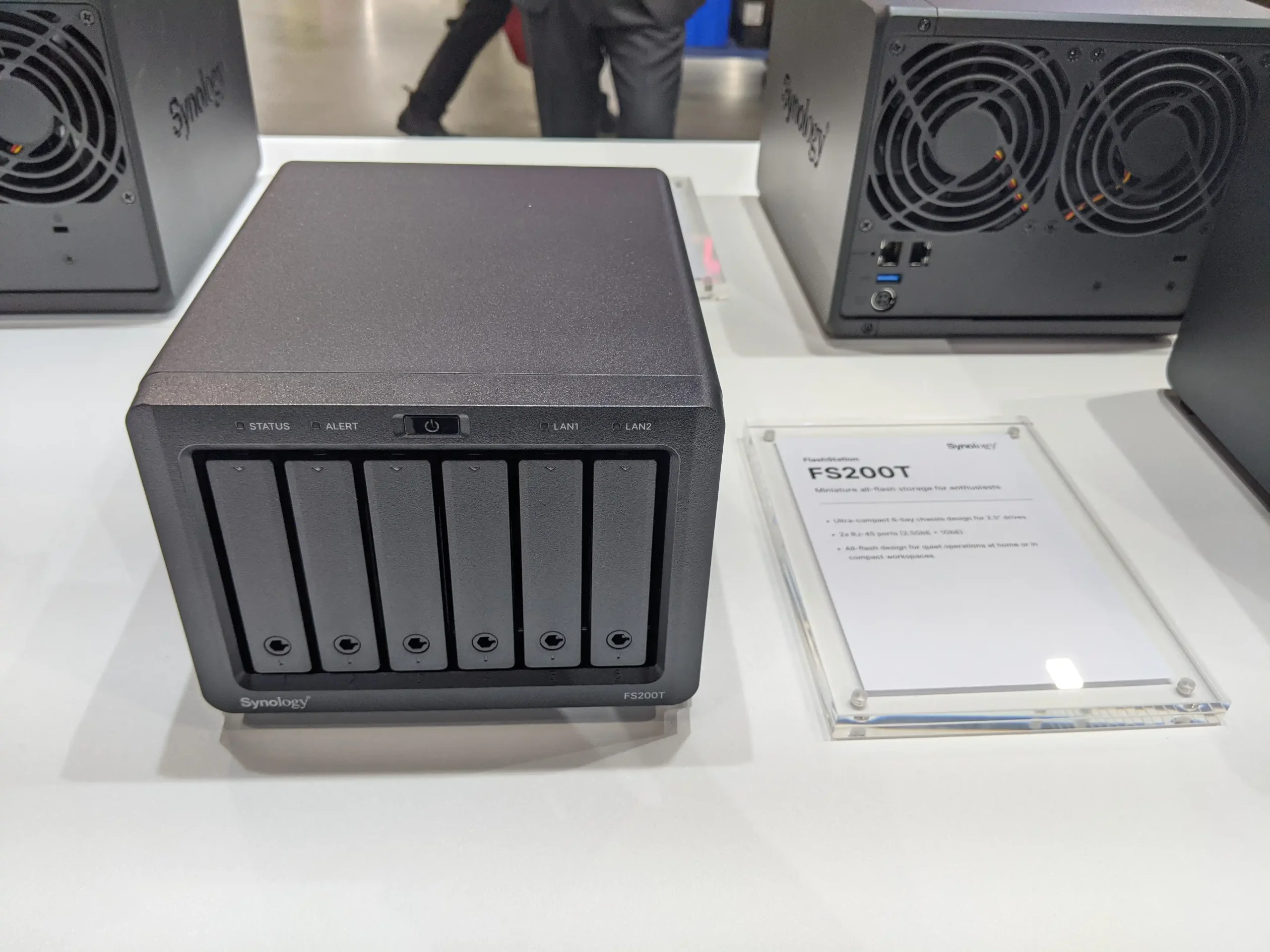
Network connectivity includes 1x 2.5GbE and 1x 1GbE RJ-45 ports, a configuration that presents a noticeable bottleneck when combined with a 6-SSD RAID setup. No PCIe or expansion options are available. Despite the performance limitations imposed by its dated processor and limited bandwidth, the FS200T’s small form factor and flash-focused design make it a viable solution for read-heavy tasks or quiet operation environments where rotational noise from HDDs is undesirable.
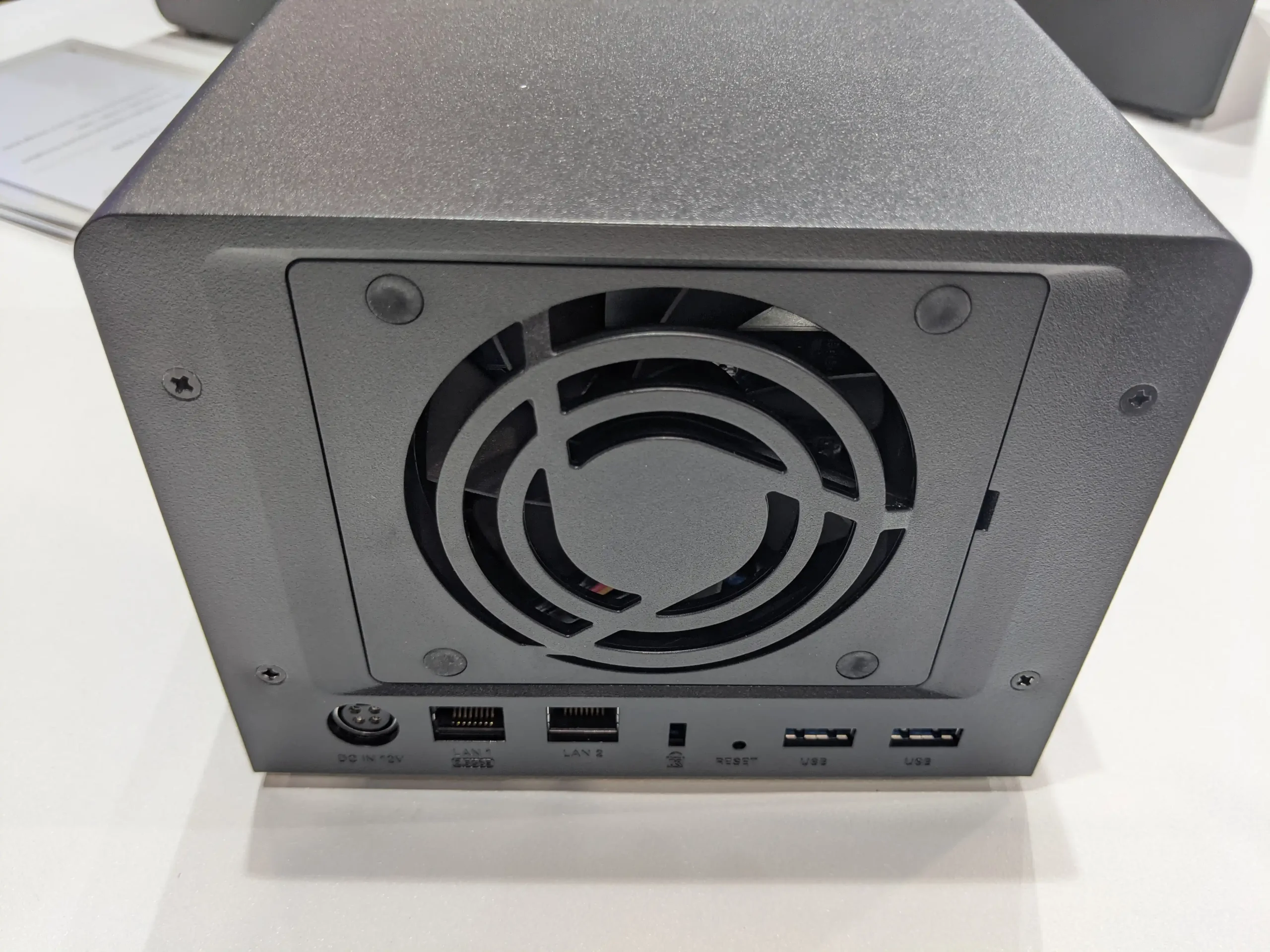
FS200T Specifications
| Feature | Details |
|---|---|
| Form Factor | Desktop, ultra-compact |
| CPU | Intel Celeron J4125 (4 cores, 4 threads) |
| Memory | 4GB DDR4 (non-ECC, upgradable TBD) |
| Drive Bays | 6 x 2.5″ SATA SSD only |
| Network Ports | 1x 2.5GbE, 1x 1GbE |
| Expansion Options | None |
| Media Compatibility | Synology-verified SATA SSDs only |
| Use Case | Quiet SSD storage for home offices, light workloads |
DS725+ – Dual-Bay Plus Series NAS with Expansion Support
The DS725+ is Synology’s latest 2-bay entry in the 2025 Plus series, offering modest upgrades over its predecessor, the DS723+. It features a 2-core, 4-thread AMD Ryzen R1600 processor, 4GB of ECC DDR4 memory (expandable), and includes two Ethernet ports: one 2.5GbE and one 1GbE. Unlike the previous model, the option for PCIe 10GbE upgrade has been removed, marking a notable downgrade in scalability.
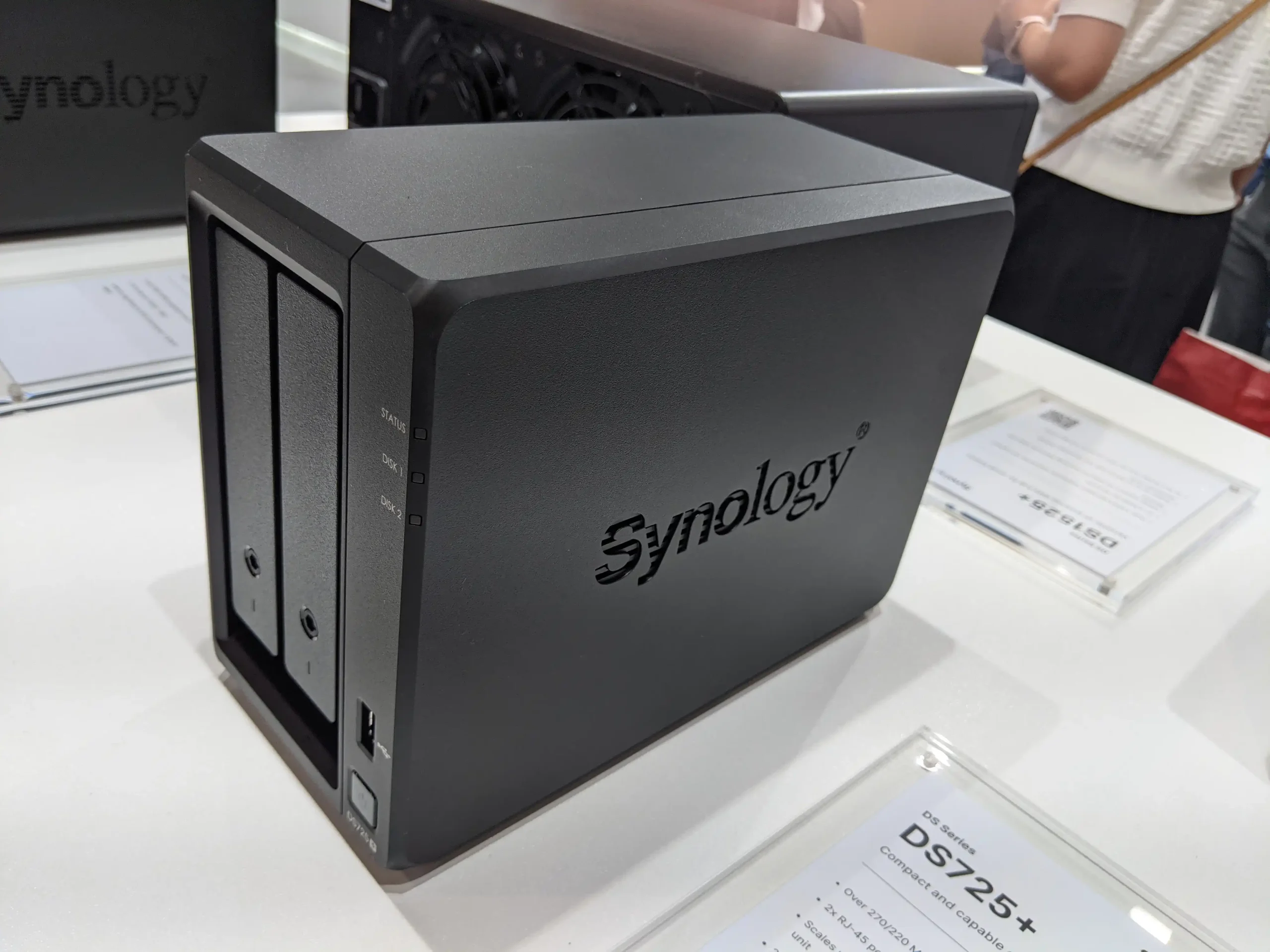
Despite its small size, the DS725+ supports expansion up to 7 total drives using the Synology DX525 USB-C expansion unit, allowing users to migrate to larger RAID arrays over time. Internally, it includes two M.2 NVMe slots that can be used for either SSD caching or storage pools, enhancing read/write performance if properly configured. However, NVMe performance may still be limited by the relatively modest CPU and system architecture.
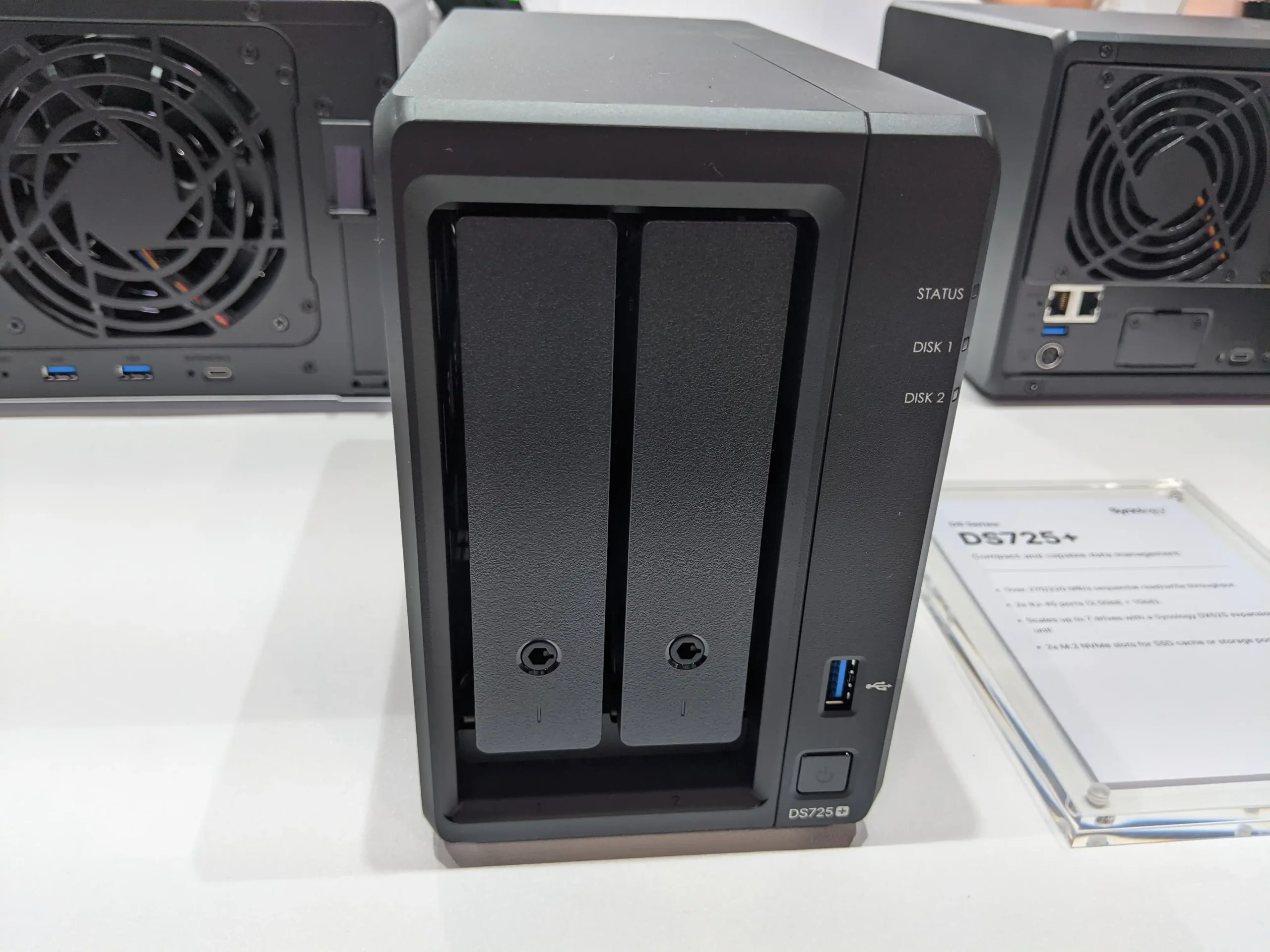
As with all 2025+ series units, this model enforces strict use of Synology-verified drives for optimal compatibility. This includes both the internal SATA bays and NVMe SSDs, aligning with Synology’s broader shift to a closed hardware ecosystem—an approach that continues to draw mixed reactions from the NAS community.
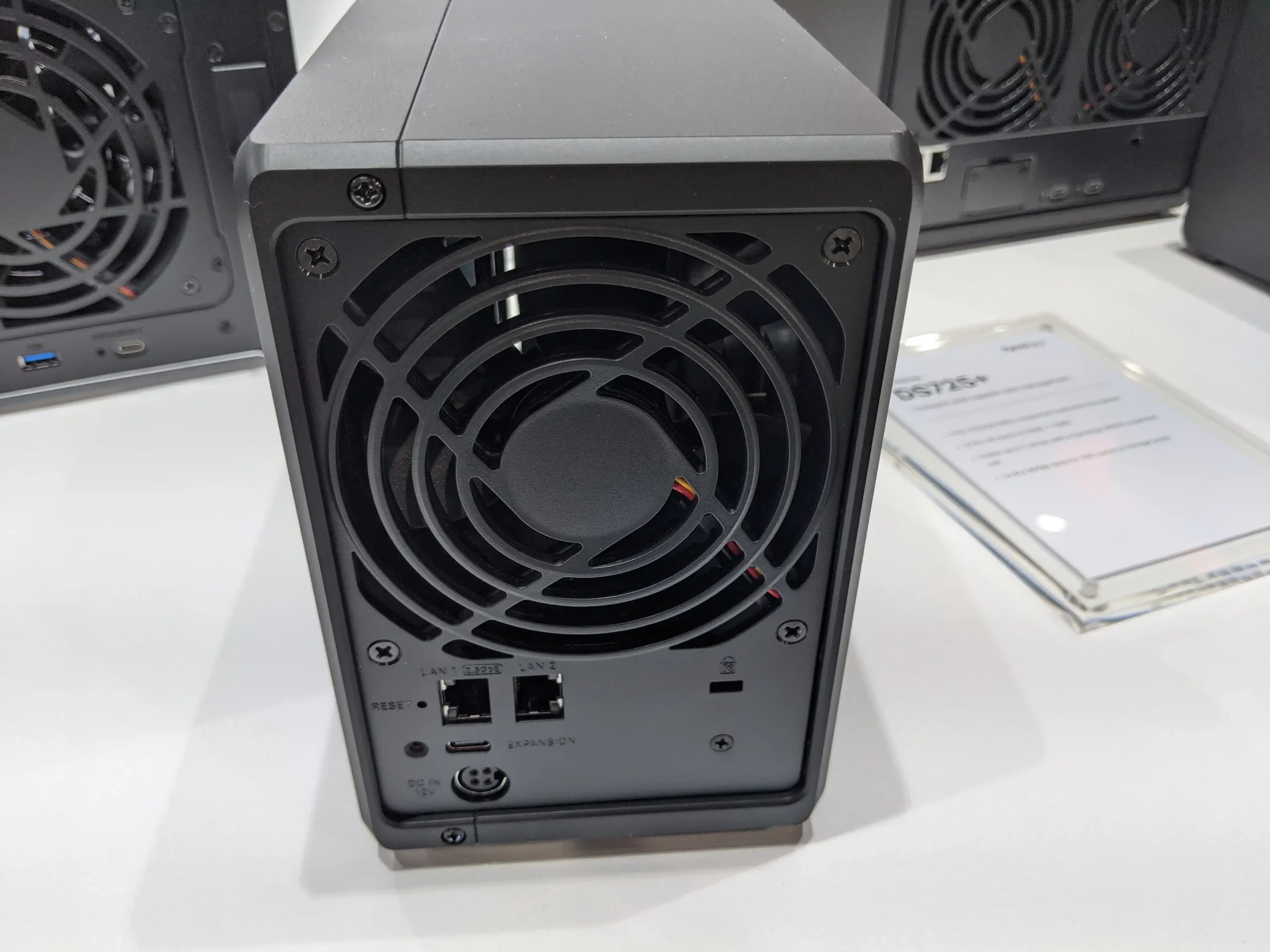
DS725+ Specifications
| Feature | Details |
|---|---|
| CPU | AMD Ryzen R1600 (2C/4T) |
| Memory | 4GB DDR4 ECC (expandable) |
| Drive Bays | 2 x 3.5″/2.5″ SATA HDD/SSD |
| M.2 Slots | 2 x NVMe (cache or storage pool) |
| Network Ports | 1 x 2.5GbE, 1 x 1GbE |
| Expansion Support | DX525 via USB-C (up to 7 total drives) |
| PCIe Slot | None (no 10GbE upgrade support) |
| Media Compatibility | Synology-verified SATA & NVMe SSDs only |
| Use Case | Small business, home backup, scalable 2-bay setup |
DS425+ – 4-Bay Multimedia NAS with Modest Refresh
The DS425+ is the 2025 refresh of the DS423+, aimed at SOHO and multimedia users seeking a 4-bay system with enhanced network throughput and M.2 NVMe support. Internally, the DS425+ continues to use the Intel Celeron J4125, a quad-core processor with integrated graphics, and comes with 4GB of DDR4 non-ECC memory. This model includes two Ethernet ports—1x 2.5GbE and 1x 1GbE—a somewhat disappointing choice that limits link aggregation potential and overall throughput compared to systems offering dual 2.5GbE.

The DS425+ includes two M.2 NVMe slots, usable for either SSD caching or as part of a storage pool. However, given the CPU and system bus limitations of the J4125, real-world NVMe performance may be constrained. There are no PCIe upgrade slots, meaning no pathway to 10GbE or further expansion beyond USB and the DX525 expansion unit.
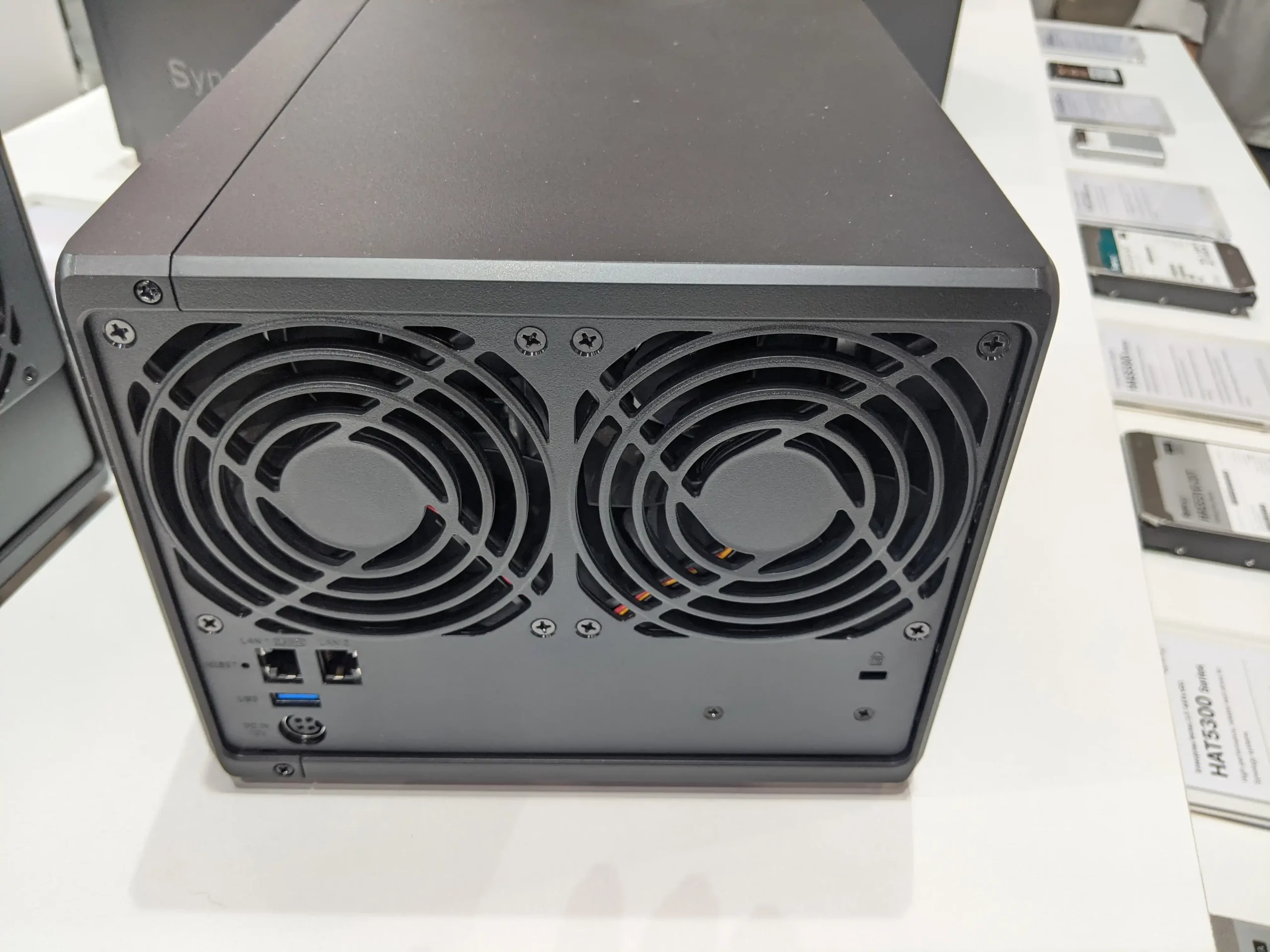
Crucially, as part of the 2025 Plus series, the DS425+ requires Synology-verified drives for compatibility—both for its SATA and NVMe bays. This has led to pushback from users accustomed to broader drive support, especially in the mid-range where cost-effectiveness and flexibility are often more important than validation.
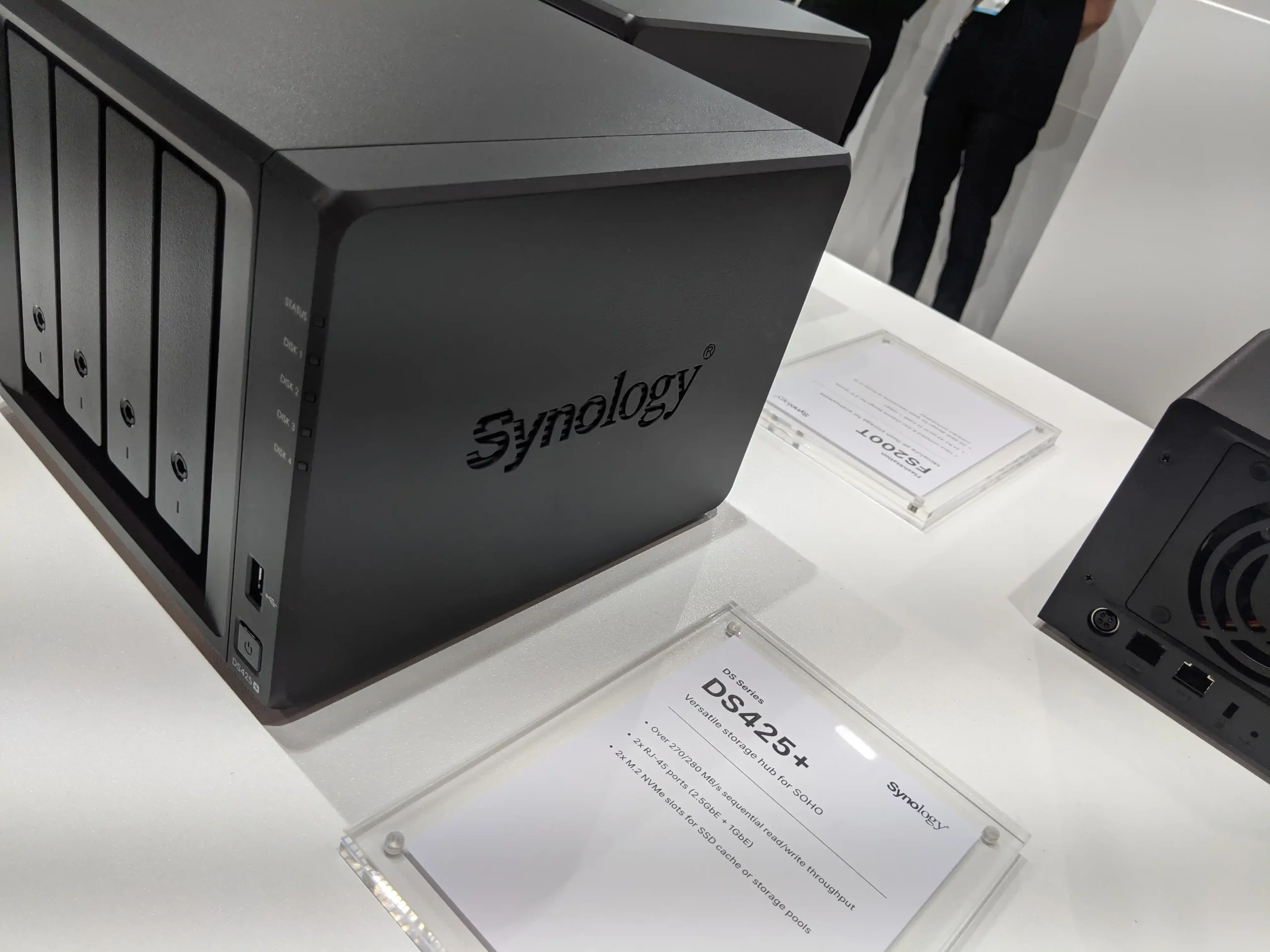
DS425+ Specifications
| Feature | Details |
|---|---|
| CPU | Intel Celeron J4125 (4 cores, 4 threads) |
| Memory | 4GB DDR4 (non-ECC, upgradable) |
| Drive Bays | 4 x 3.5″/2.5″ SATA |
| M.2 Slots | 2 x NVMe (cache or storage pool) |
| Network Ports | 1 x 2.5GbE, 1 x 1GbE |
| Expansion Support | DX525 via USB-C (up to 9 total drives) |
| PCIe Slot | None |
| Media Compatibility | Synology-verified SATA & NVMe SSDs only |
| Use Case | Multimedia, Plex, home backups, SOHO storage |
DS1525+ – 5-Bay All-Purpose NAS with Enhanced CPU and Expansion
The DS1525+ sits in the middle of Synology’s Plus series, offering a blend of scalability, multimedia handling, and business backup functionality. It upgrades the CPU from the DS1522+ by moving from the AMD Ryzen R1600 (2C/4T) to the AMD Ryzen V1500B, a 4-core, 8-thread processor that previously powered the DS1621+ and DS1821+. The system comes pre-installed with 8GB of DDR4 ECC memory, double that of its predecessor.
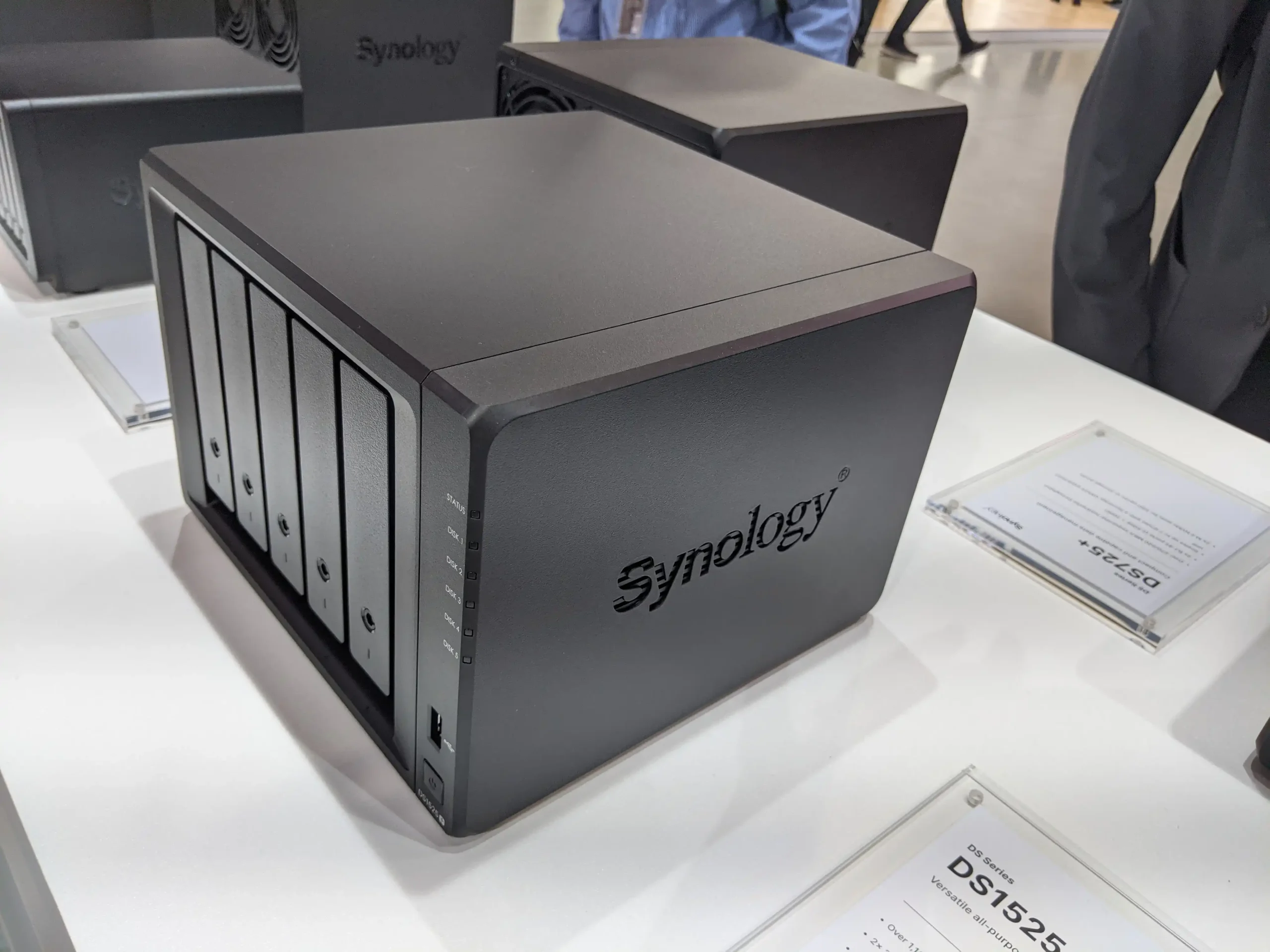
The DS1525+ includes two 2.5GbE RJ-45 network ports and supports the Synology Network Upgrade Module, which provides a pathway to 10GbE networking via a compact add-in module. This model also retains two M.2 NVMe slots for SSD caching or storage pool creation. It supports expansion to 15 total drives when connected to two DX525 expansion units, making it suitable for growing media libraries or multi-user project environments.
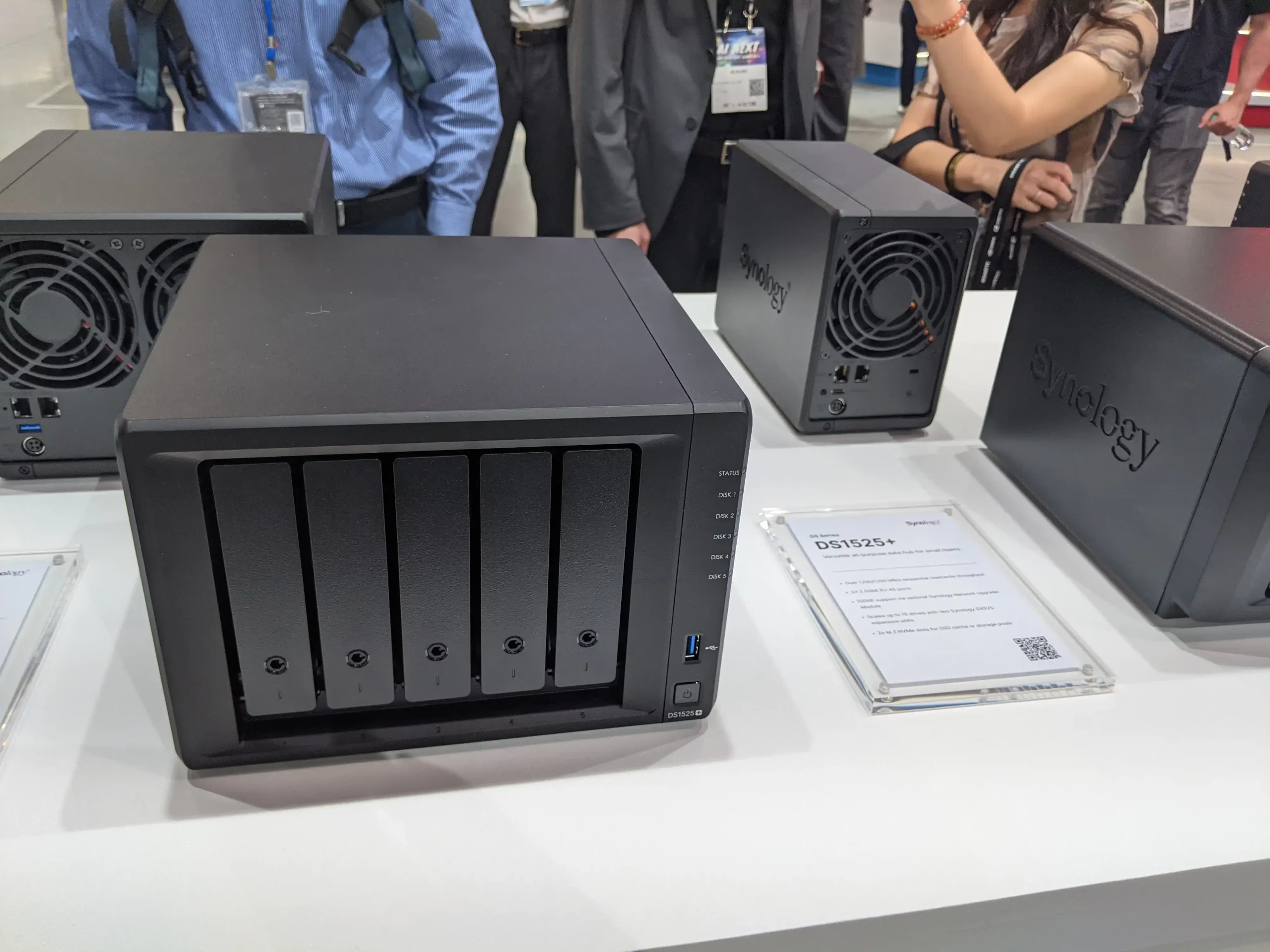
However, it still falls under Synology’s 2025 policy requiring Synology-verified storage media, both for the five primary SATA bays and the M.2 NVMe slots. This requirement continues to stir user debate, particularly in the mid-range segment, where third-party storage flexibility has historically been an expectation.

DS1525+ Specifications
| Feature | Details |
|---|---|
| CPU | AMD Ryzen V1500B (4 cores, 8 threads) |
| Memory | 8GB DDR4 ECC (expandable) |
| Drive Bays | 5 x 3.5″/2.5″ SATA |
| M.2 Slots | 2 x NVMe (cache or storage pool) |
| Network Ports | 2 x 2.5GbE RJ-45 |
| 10GbE Support | Yes, via Synology Network Upgrade Module |
| Expansion Support | Up to 15 drives with 2x DX525 |
| PCIe Slot | Not full-sized PCIe (uses mini-module instead) |
| Media Compatibility | Synology-verified SATA & NVMe SSDs only |
| Use Case | Multimedia, workgroup storage, backup, light VM use |
DS1825+ – 8-Bay High-Capacity NAS for Power Users and SMBs
The DS1825+ serves as the high-capacity flagship in the 2025 Plus series, aimed at power users and small to medium businesses that require extensive storage and moderate processing capabilities. Like the DS1525+, it is powered by the AMD Ryzen V1500B (4 cores, 8 threads) and includes 8GB of ECC DDR4 memory by default. The unit offers two 2.5GbE RJ-45 ports, replacing the four 1GbE ports found in its predecessor, the DS1821+.
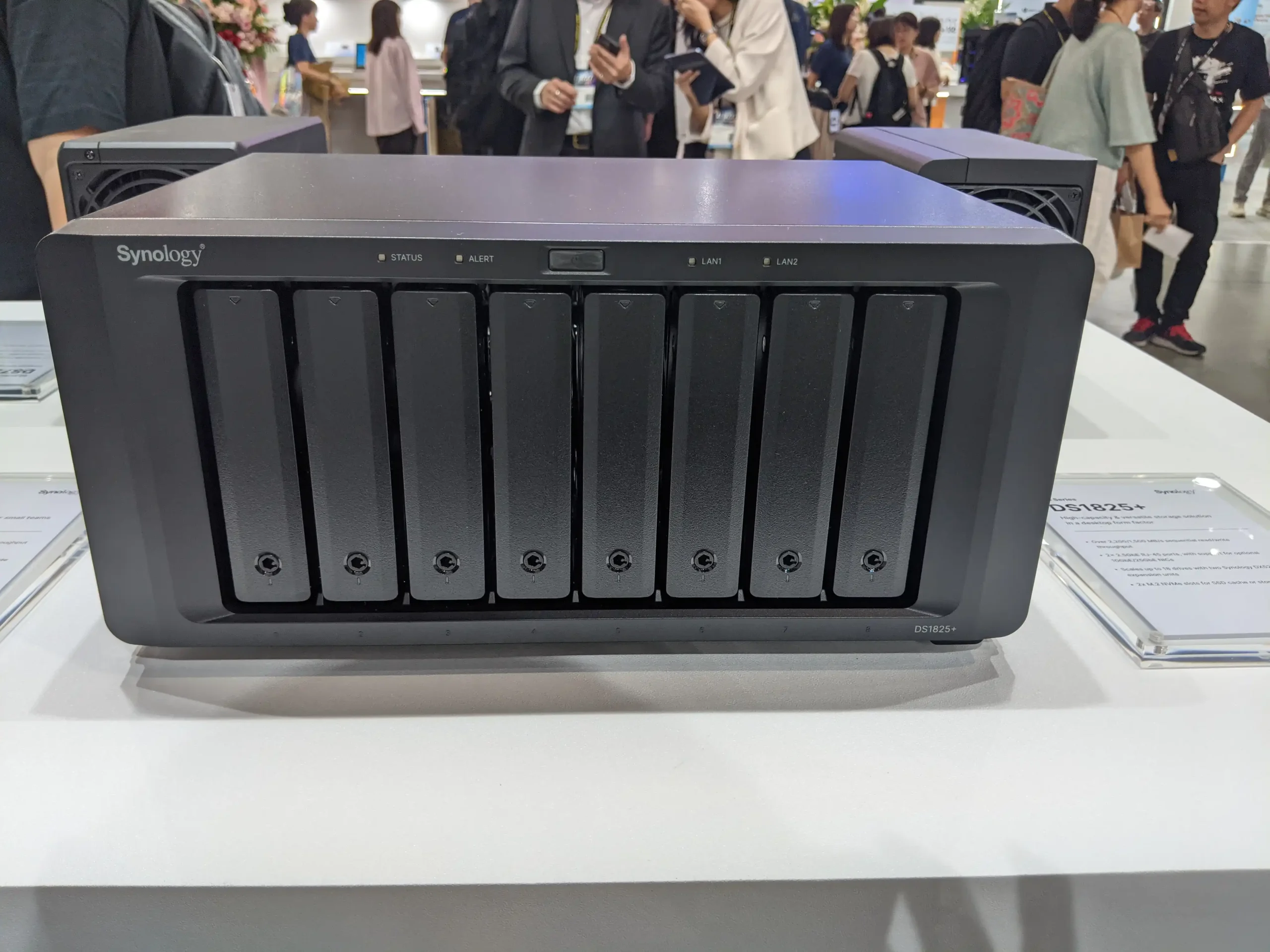
Storage can be expanded up to 18 total drives by connecting two DX525 expansion units via USB-C. The DS1825+ also includes two M.2 NVMe slots, supporting both SSD caching and dedicated NVMe storage pools. Unlike the DS1525+, it retains a standard PCIe slot, supporting full-sized 10GbE and higher NICs—with Synology now offering 25GbE and 50GbE upgrade cards, expanding its relevance in virtualization and high-bandwidth media workflows.
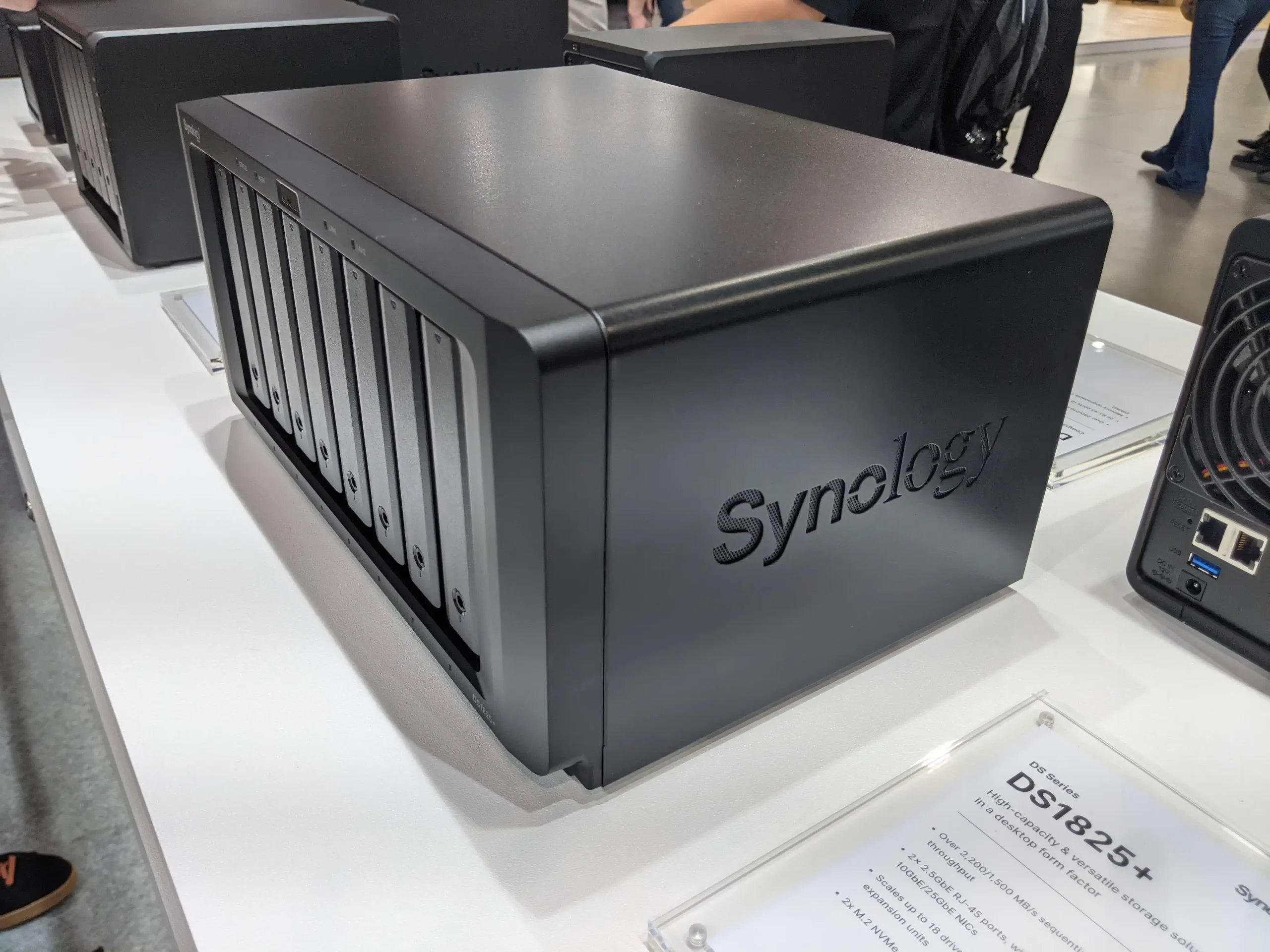
However, as with all devices in the 2025 Plus series, the DS1825+ enforces Synology’s drive verification system. Only Synology-verified SATA drives and NVMe SSDs are supported for optimal operation, and unsupported drives may be flagged or disabled in future DSM updates—a policy that continues to concern experienced users building mixed-brand NAS environments.
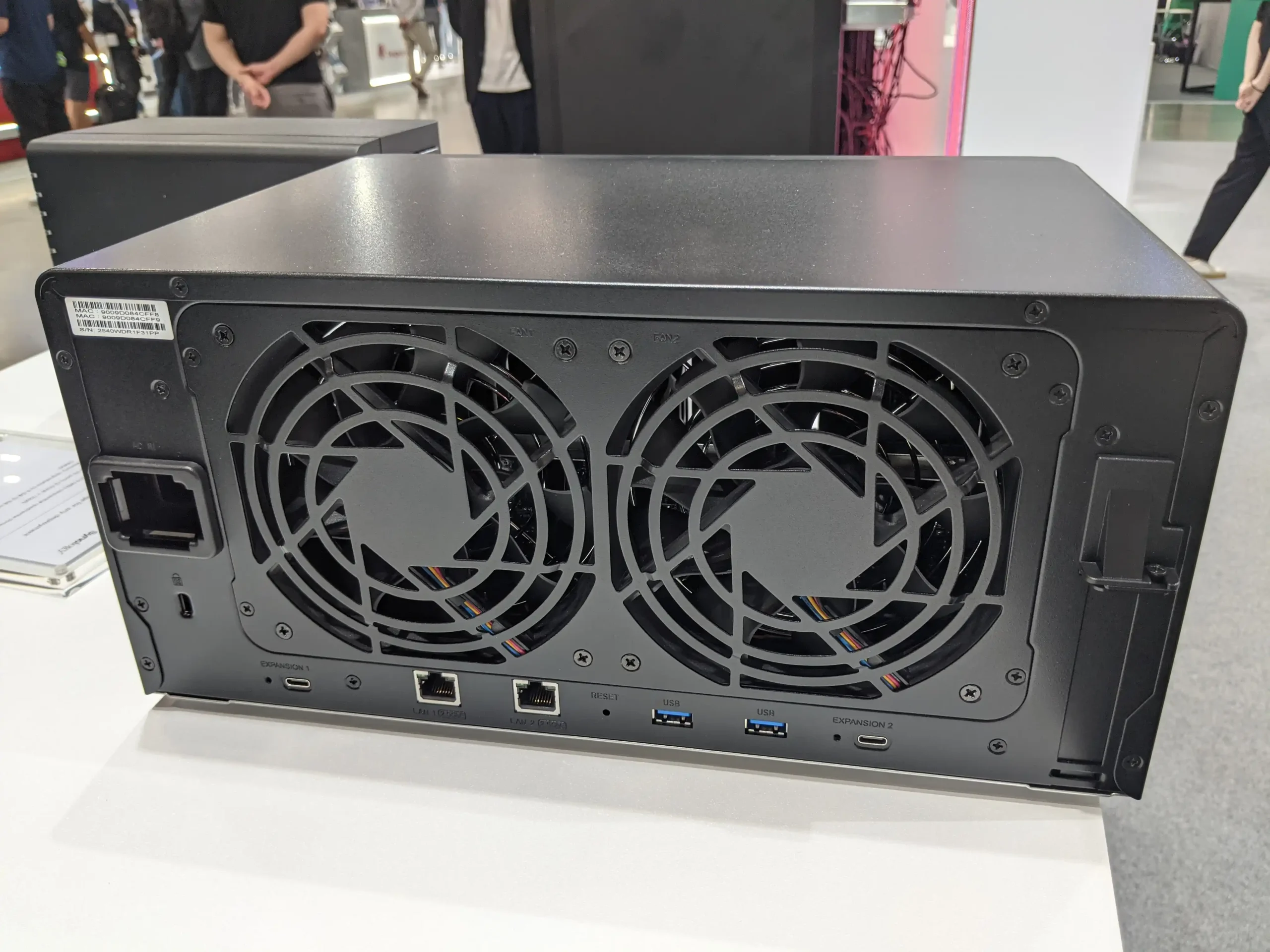
DS1825+ Specifications
| Feature | Details |
|---|---|
| CPU | AMD Ryzen V1500B (4 cores, 8 threads) |
| Memory | 8GB DDR4 ECC (expandable) |
| Drive Bays | 8 x 3.5″/2.5″ SATA |
| M.2 Slots | 2 x NVMe (cache or storage pool) |
| Network Ports | 2 x 2.5GbE RJ-45 |
| PCIe Slot | 1 x PCIe (supports 10/25/50GbE NICs) |
| Expansion Support | Up to 18 drives with 2x DX525 |
| Media Compatibility | Synology-verified SATA & NVMe SSDs only |
| Use Case | Virtualization, large-scale media storage, backup |
DX525 – 5-Bay Expansion Unit for DS and Plus Series
The DX525 is Synology’s latest 5-bay expansion unit, designed for use with a wide range of their 2025 DS and Plus series NAS models. It connects via USB-C rather than the older eSATA standard, supporting newer devices such as the DS725+, DS425+, DS1525+, DS1825+, DS925+, and others.
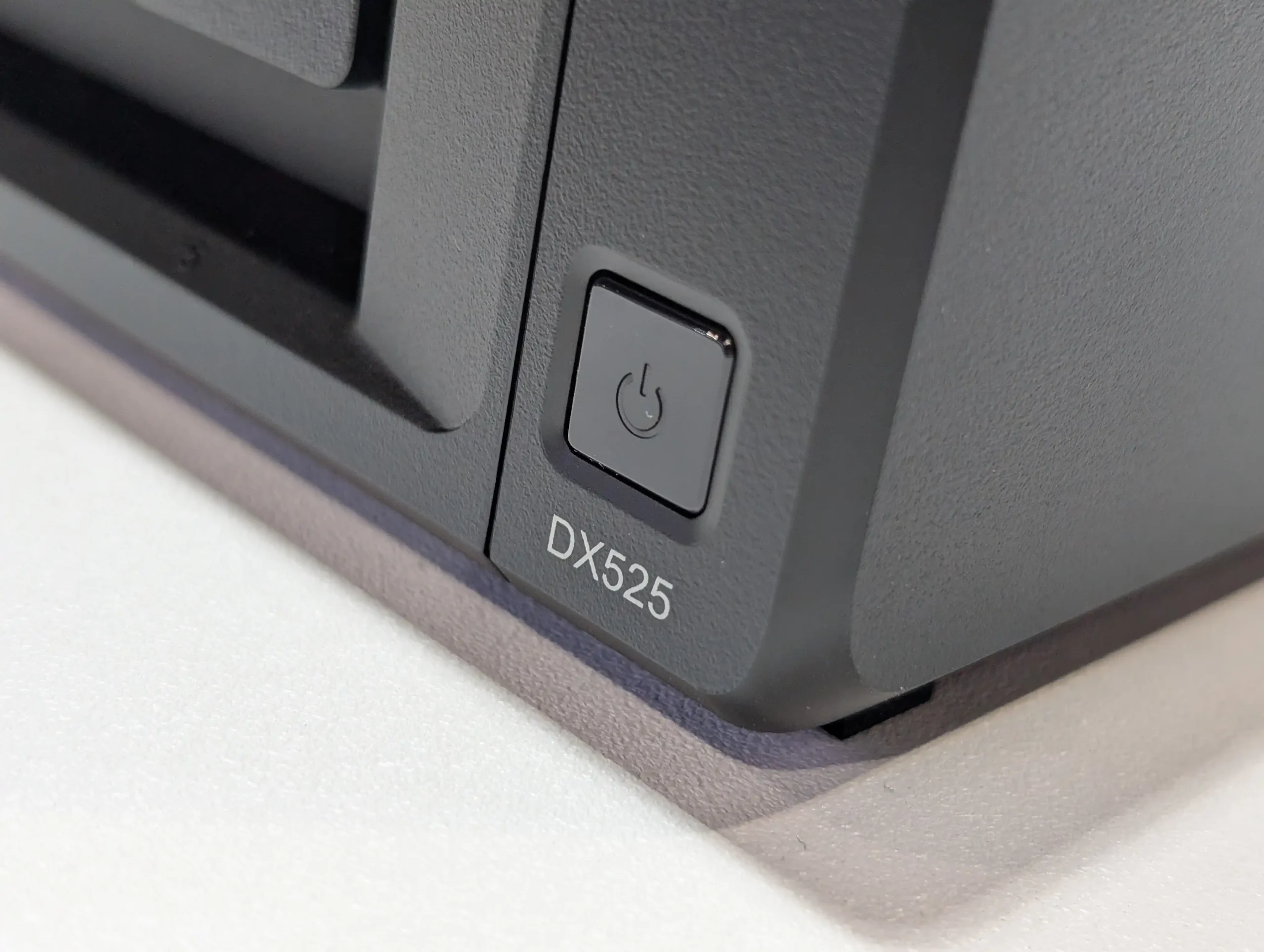
It provides a seamless way to expand storage without migrating to a larger system or creating a new volume, and is fully integrated into DSM’s Storage Manager for volume extension and RAID expansion.
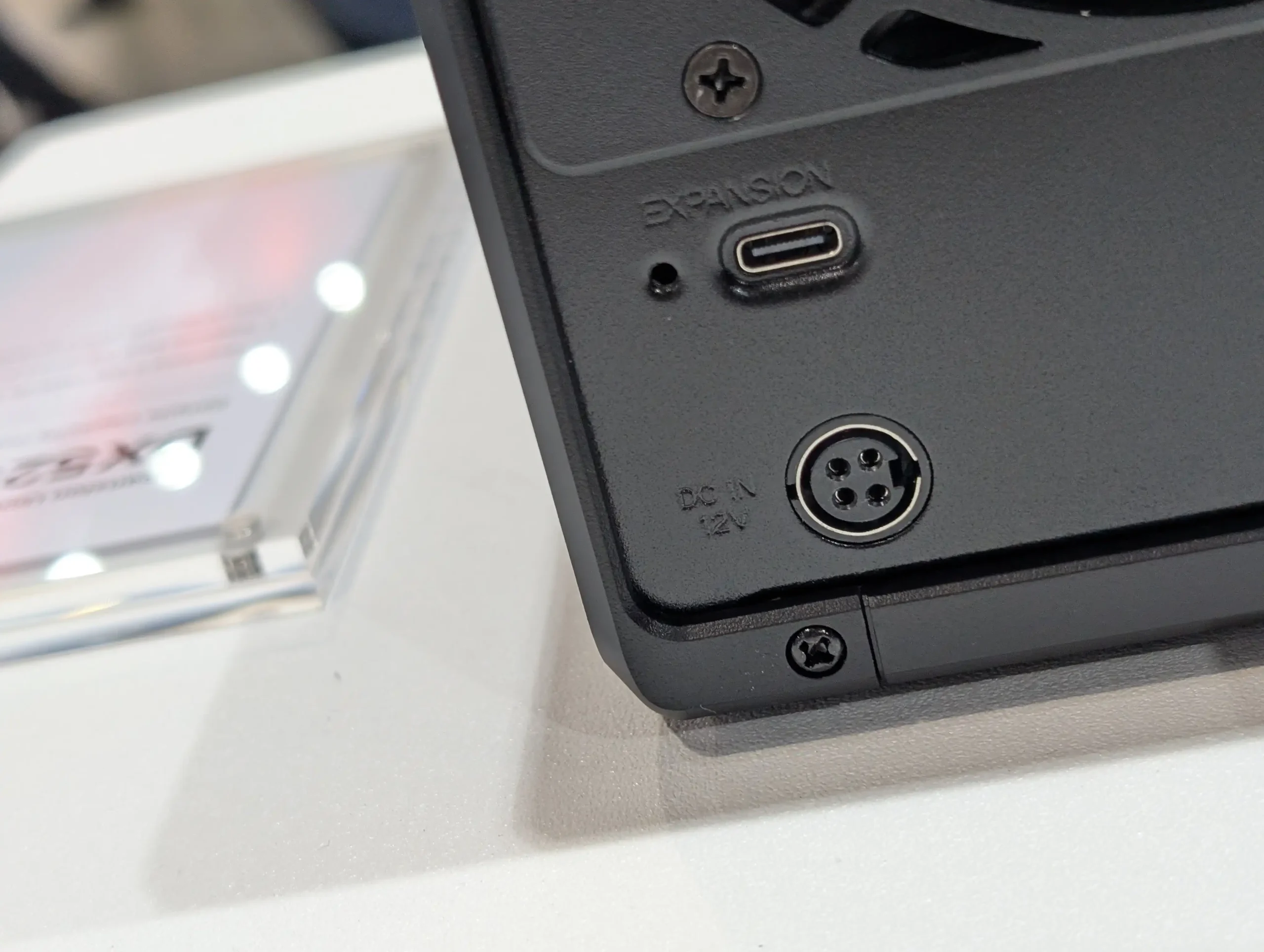
The DX525 supports both 3.5″ and 2.5″ SATA drives, with hot-swappable trays for quick replacement. While no network or processing capability exists on the unit itself (it’s entirely dependent on the host NAS), it can be used for extending existing RAID volumes or creating new independent volumes. This makes it useful for both capacity growth and tiered storage strategies.
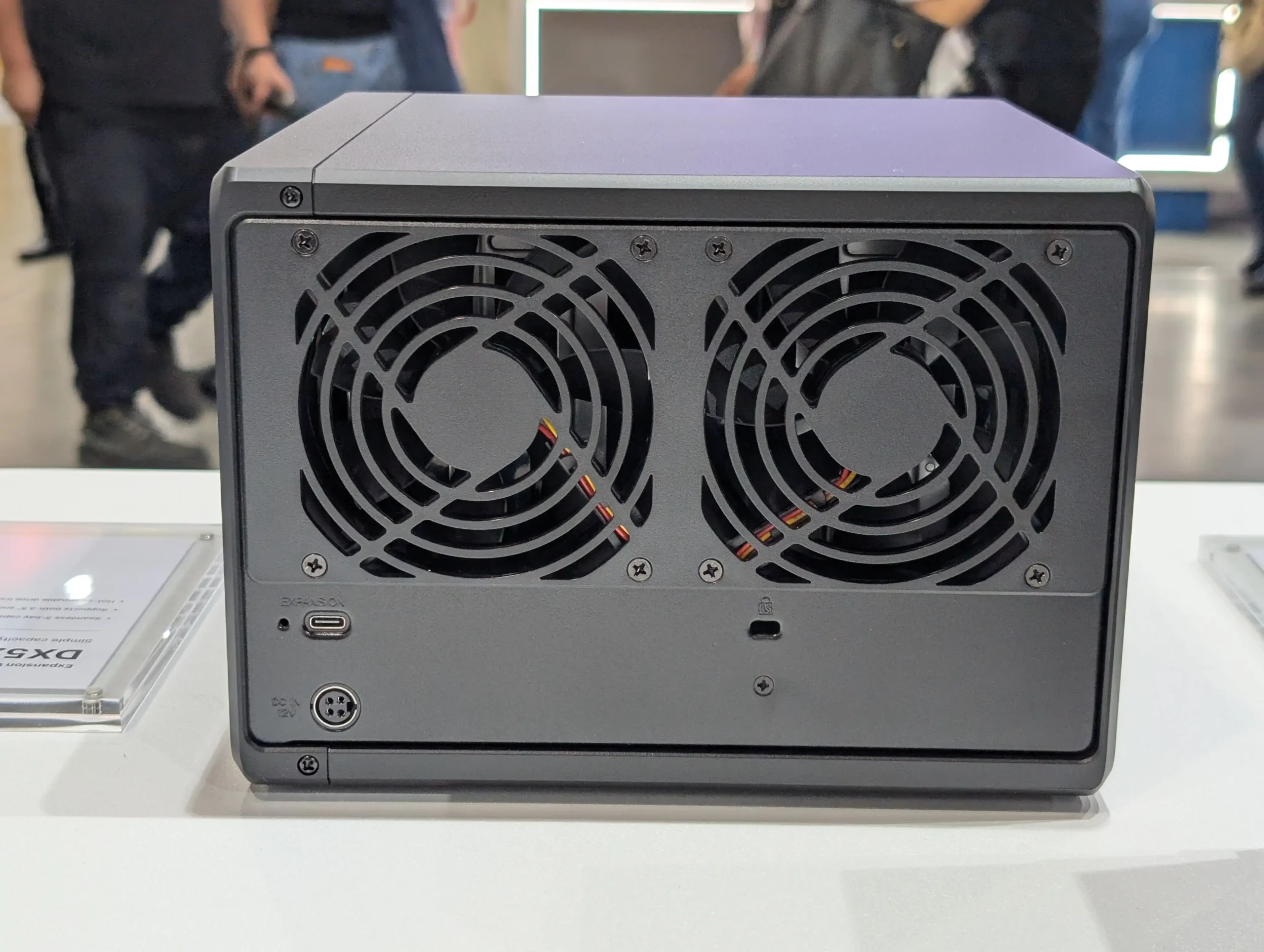
DX525 Specifications
| Feature | Details |
|---|---|
| Drive Bays | 5 x 3.5″/2.5″ SATA (hot-swappable) |
| Interface | USB-C (to host NAS) |
| Compatible Systems | DS225+, DS425+, DS725+, DS925+, DS1525+, DS1825+ |
| Power Supply | External (built-in PSU) |
| Expansion Mode | Volume extension, new volume creation (via DSM) |
| Media Compatibility | Synology-verified SATA drives only |
| Use Case | Capacity expansion for growing NAS volumes |
SNV5420 – Enterprise NVMe SSD for Sustained Caching Workloads
The SNV5400 is Synology’s newest high-performance M.2 NVMe SSD for caching and sustained-write workloads, positioned above the earlier SNV3400 series. Targeted at SMBs and enterprise deployments requiring high-speed caching, the SNV5400 delivers up to 660,000 random read IOPS and 120,000 random write IOPS, with a rated endurance of 2,900 TBW. It features end-to-end data protection and power loss protection, ensuring data integrity during unexpected shutdowns—essential for cache-tier applications in critical environments.
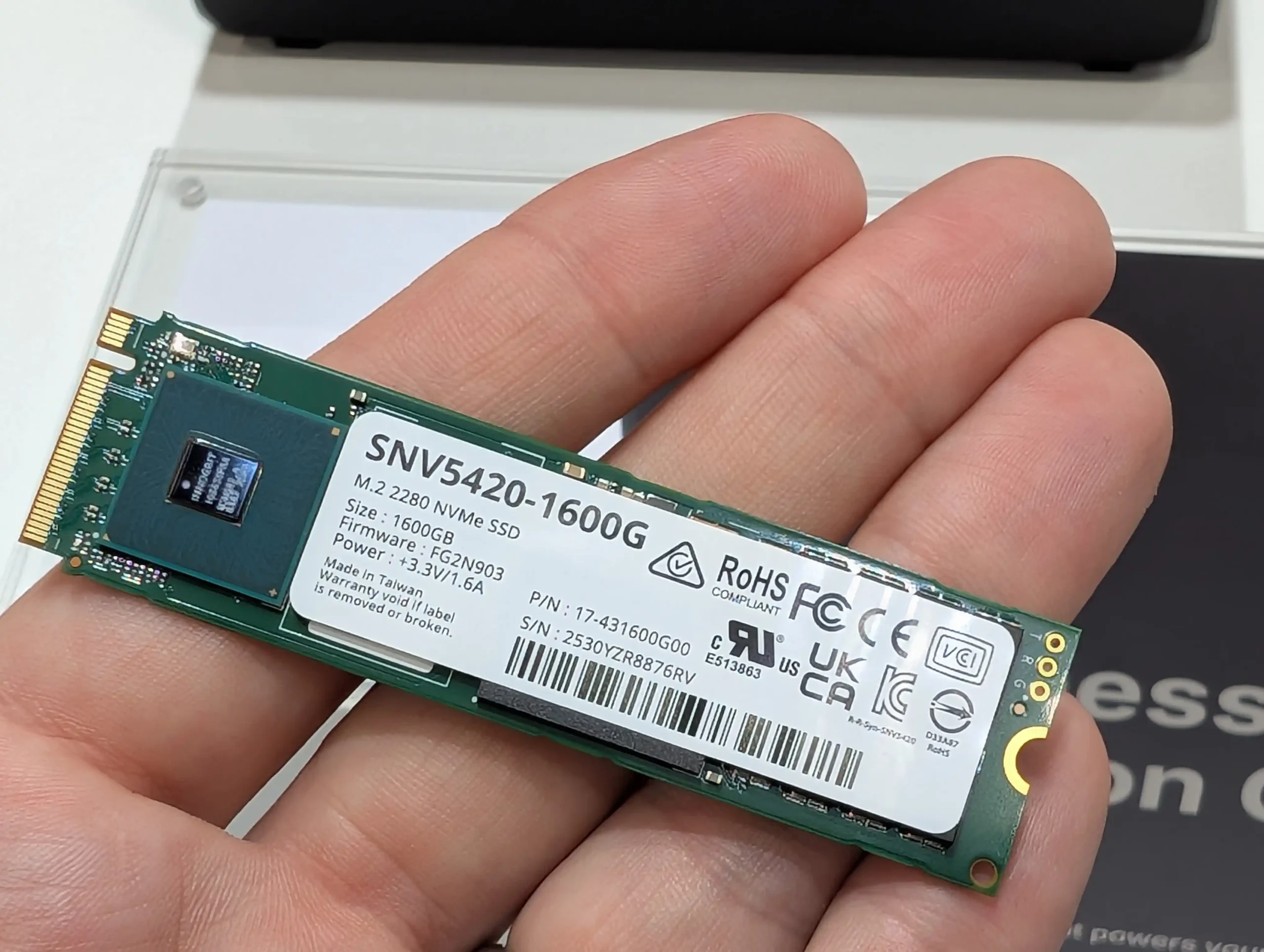
Unlike previous Synology NVMe SSDs, the SNV5400 also supports in-system firmware upgrades, reducing maintenance downtime during drive management or lifecycle refresh. It is available in at least one confirmed variant, though broader capacity options have not yet been fully disclosed. The controller used is reportedly the IG5636 FAA, believed to be a Gen4 NVMe controller, but Synology has not publicly confirmed full hardware details or OEM sourcing. In addition to the SNV5400 enterprise drive, Synology showed off a new high-performance M.2 NVMe SSD at Computex 2025 that appears to target heavier workloads than the SNV3400. It reportedly uses the IG5636 FAA controller, which supports PCIe Gen4, suggesting significantly higher throughput than their current Gen3 offerings. However, Synology did not publicly confirm specs such as endurance, capacity range, or the NAND type used.
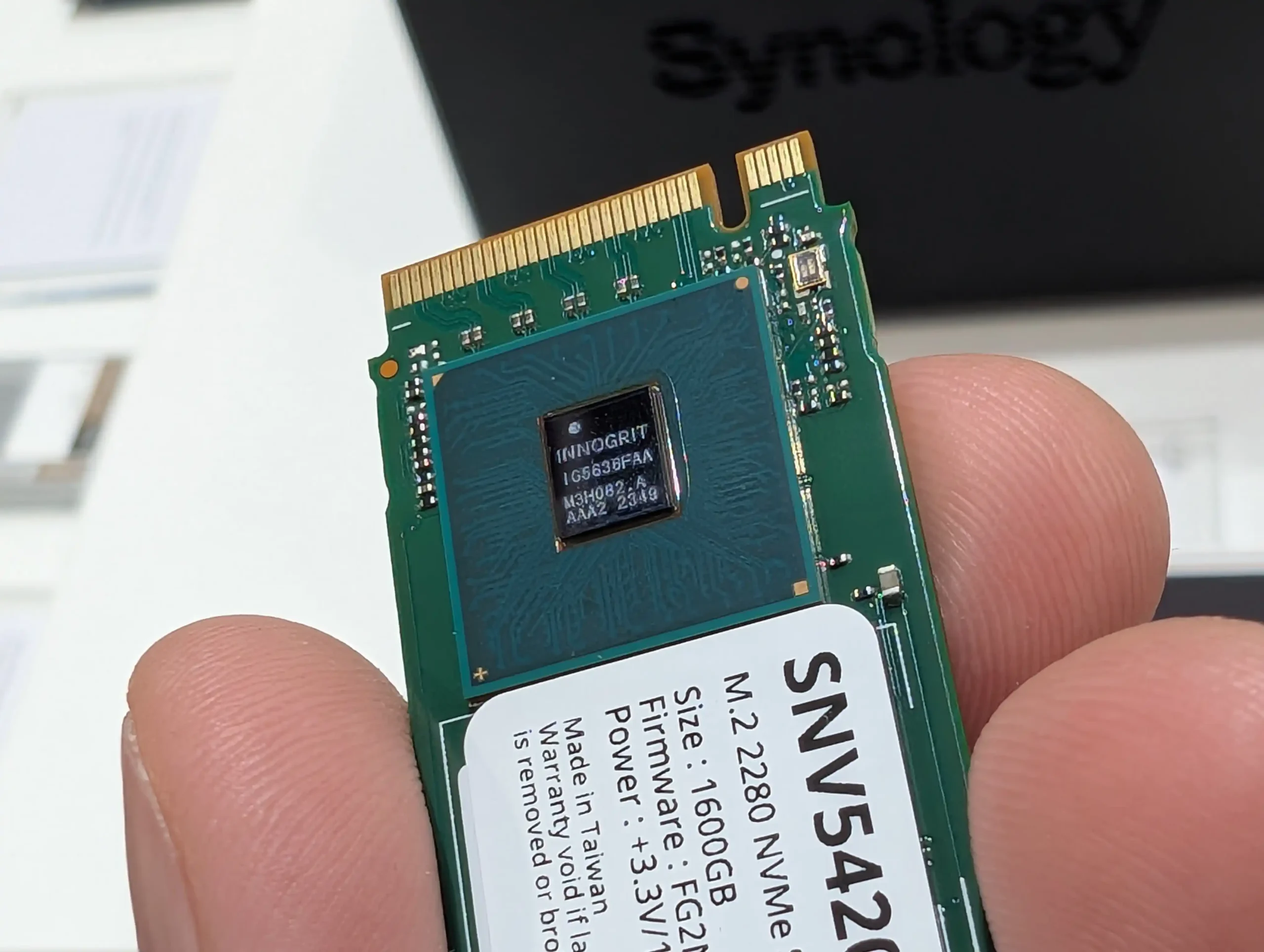
This unnamed SSD is presumed to be part of a future SNV or new series aimed at advanced caching, AI workloads, or even storage pool applications in high-performance Plus and enterprise NAS models. Synology staff on the show floor were unable to confirm OEM origins or whether this model would be mandatory in future NVMe-capable systems.
| Feature | Details |
|---|---|
| Controller | IG5636 FAA (PCIe Gen4) |
| Status | Prototype / not yet formally announced |
| Intended Use | High-speed caching or NVMe storage pools |
| Performance Tier | Above SNV3400, likely near or above SNV5400 |
| Media Policy | Expected to be Synology-verified only |
| Use Case | Advanced caching, potential AI/video acceleration pools |
| Feature | Details |
|---|---|
| Form Factor | M.2 2280 NVMe (PCIe Gen3/4, TBD) |
| Interface | NVMe (likely Gen4 x4) |
| Max Random Read IOPS | 660,000 |
| Max Random Write IOPS | 120,000 |
| Endurance | 2,900 TBW |
| Power Loss Protection | Yes |
| In-System Firmware Updates | Supported |
| Use Case | SSD caching for DSM volumes, VM storage pools |
HAT5300 20TB – Synology’s Largest Enterprise-Grade HDD
The HAT5300 20TB is the latest and highest-capacity addition to Synology’s line of enterprise SATA hard drives, extending the HAT5300 series for large-volume and high-workload environments. Designed specifically for compatibility with Synology’s 2025 NAS and SAN systems, this 3.5-inch SATA drive offers up to 23% higher sustained sequential read performance than previous models, positioning it as a reliable option for high-throughput backup, archival, and surveillance storage tasks.

The drive supports workloads of up to 550 TB/year, making it suitable for 24/7 operation in business-critical storage arrays. It also includes persistent write cache technology, which helps preserve data integrity during power loss events. Like other models in the HAT5300 line, this drive undergoes over 500,000 hours of internal validation on Synology systems and supports in-system firmware upgrades directly via DSM.
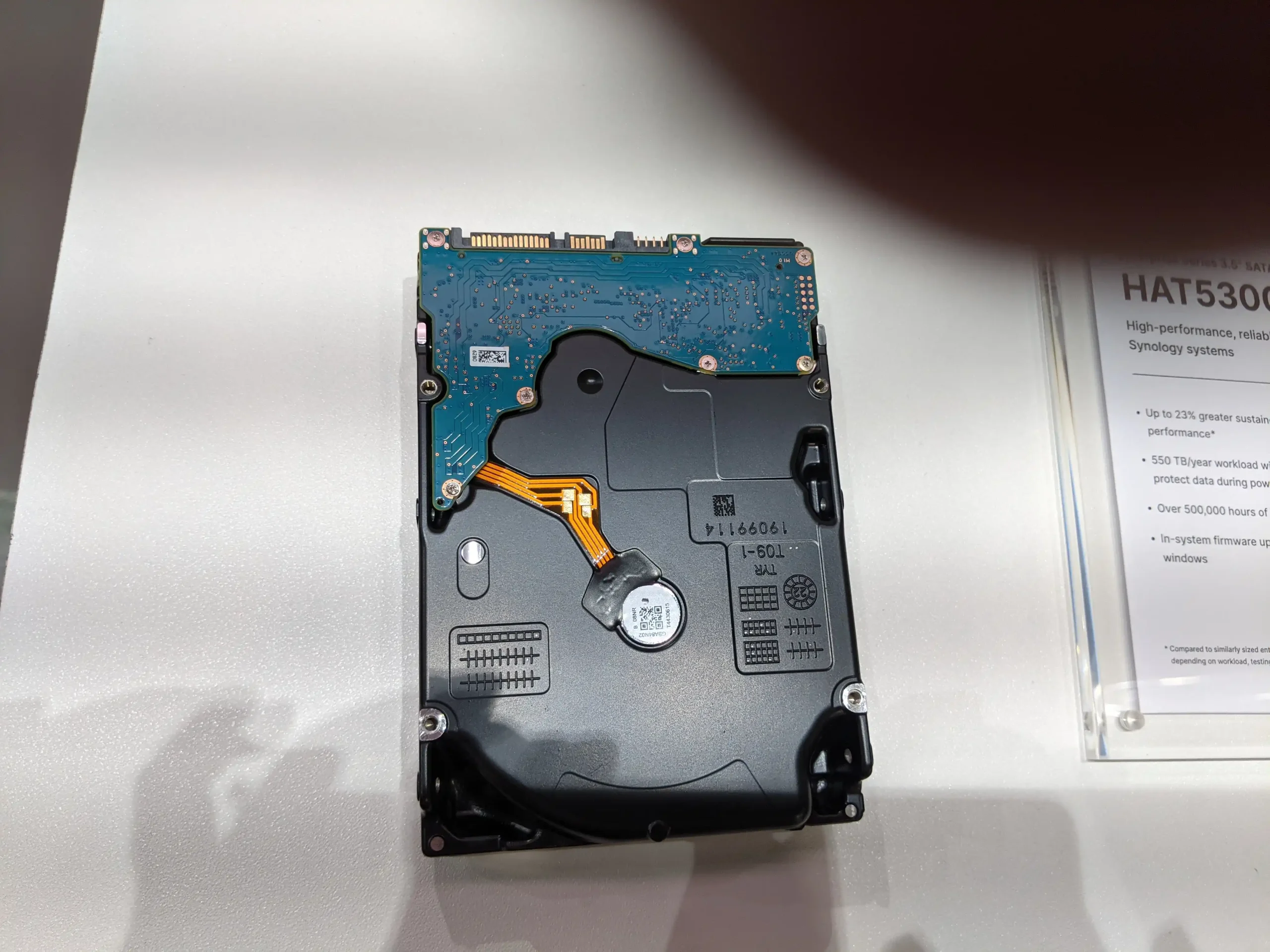
This is currerntly the largest hard drive offered by Synology in their existing line up of storage media drives.
HAT5300 20TB Specifications
| Feature | Details |
|---|---|
| Form Factor | 3.5″ SATA HDD |
| Capacity | 20TB |
| Sustained Read Speed | Improved (up to 23% higher than previous HAT models) |
| Workload Rating | 550 TB/year |
| Persistent Write Cache | Yes |
| Validation | 500,000+ hours of stress testing |
| In-System Firmware Updates | Supported via DSM |
| Media Policy | Synology-verified only (required in 2025 series) |
| Use Case | Enterprise backup, media storage, high-capacity arrays |
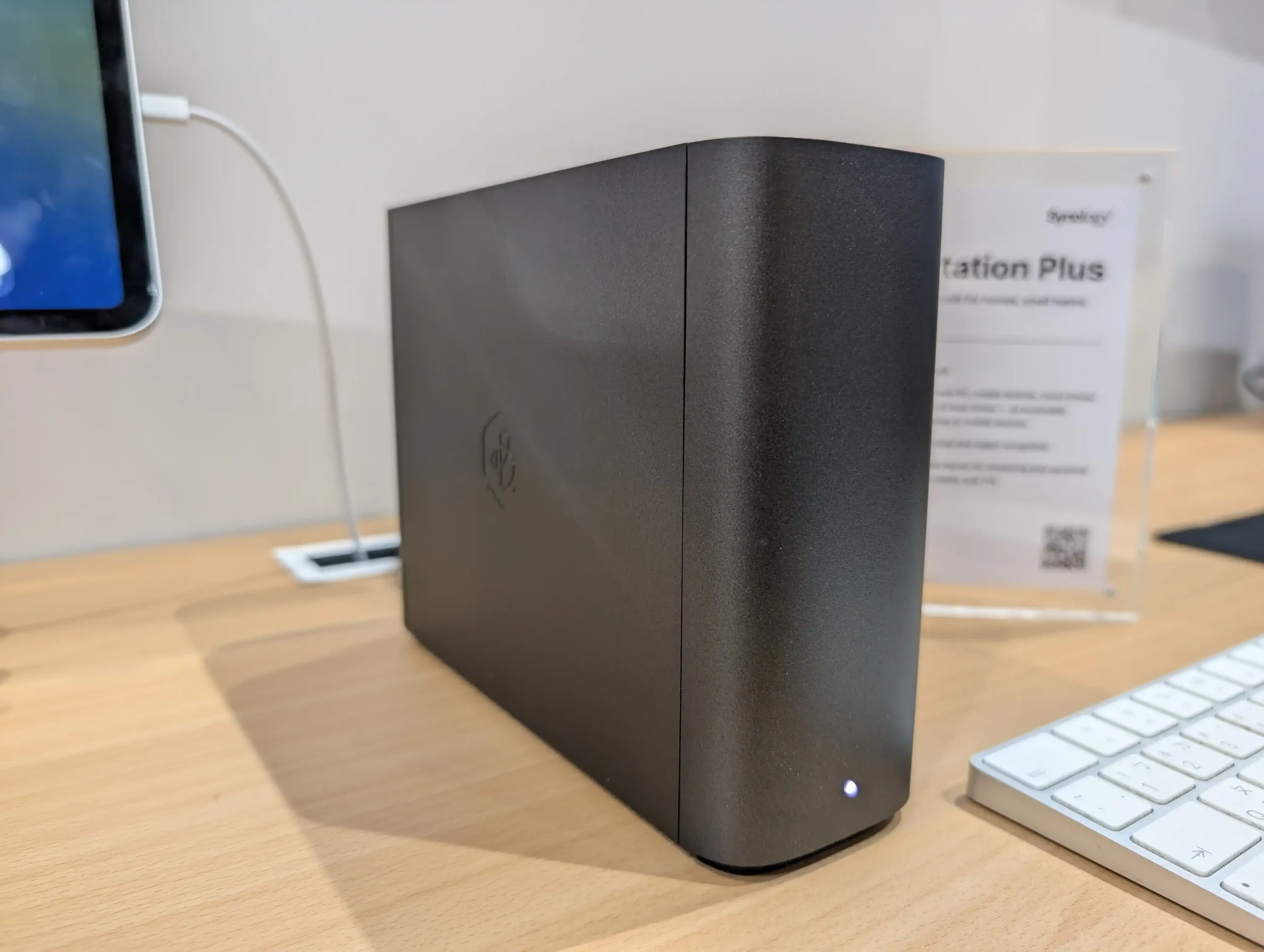
BeeStation Plus – Preconfigured Private Cloud with Plex and AI Tools
The BeeStation Plus is Synology’s latest entry in the consumer-grade NAS lineup, positioned as a plug-and-play private cloud aimed at home users, content creators, and families. It comes pre-populated with an 8TB Synology HAT3300 Plus hard drive, sealed within a single-bay enclosure that does not allow for internal drive replacement or expansion. This closed-box approach prioritizes simplicity but removes RAID failover and user-serviceability, relying instead on USB or cloud-based backups.
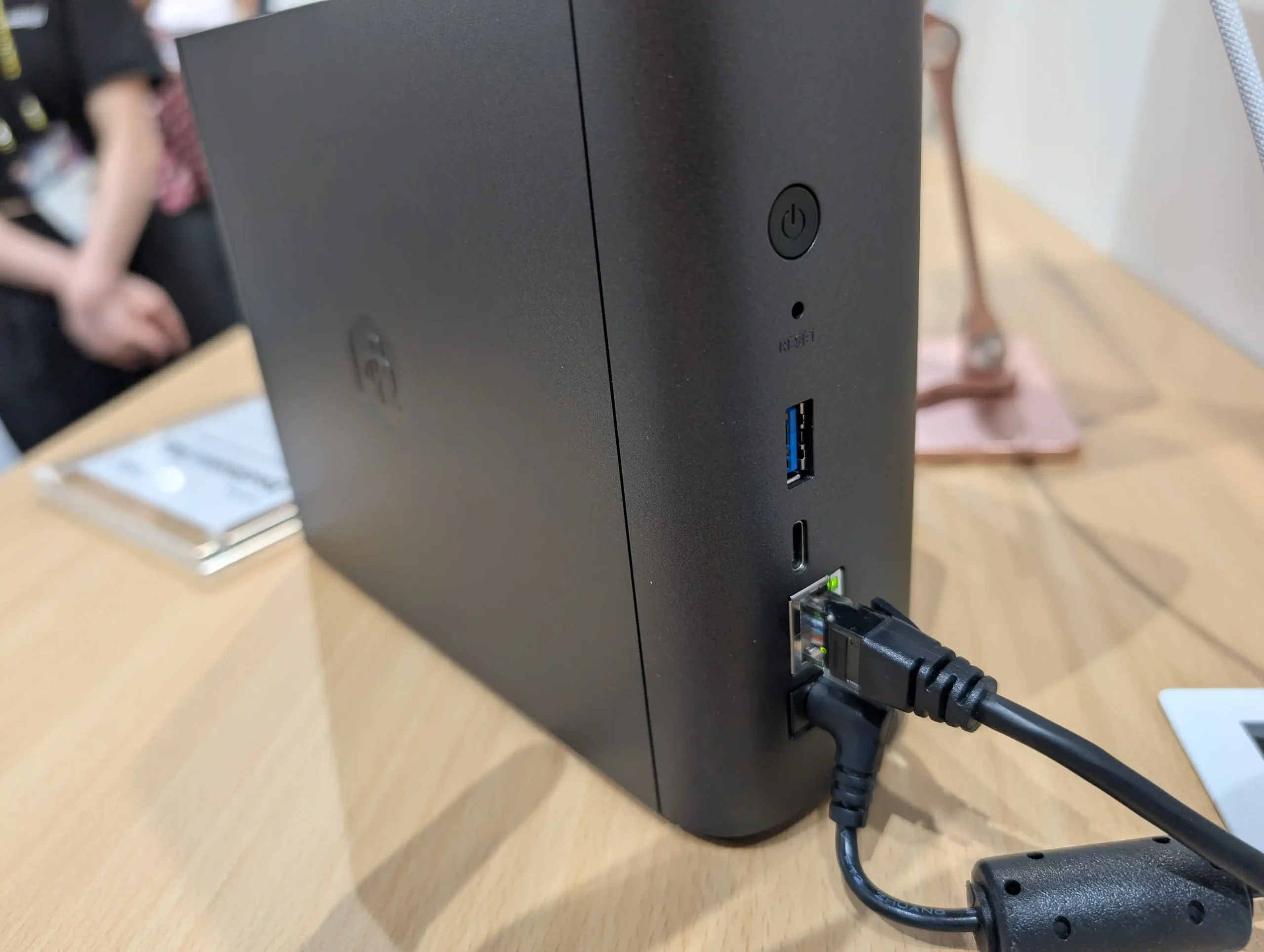
Internally, the BeeStation Plus runs on an Intel Celeron J4125 processor—an aging but capable quad-core CPU with integrated graphics. It is paired with 8GB of memory, doubling that of the original ARM-based BeeStation. The device ships with Synology’s BeeStation Manager (BSM) software preinstalled and fully configured Plex Media Server, with media libraries and directories already initialized, enabling fast setup for streaming to smart TVs, tablets, and mobile devices. It also features local AI-powered photo indexing and object recognition via Bee Photos.
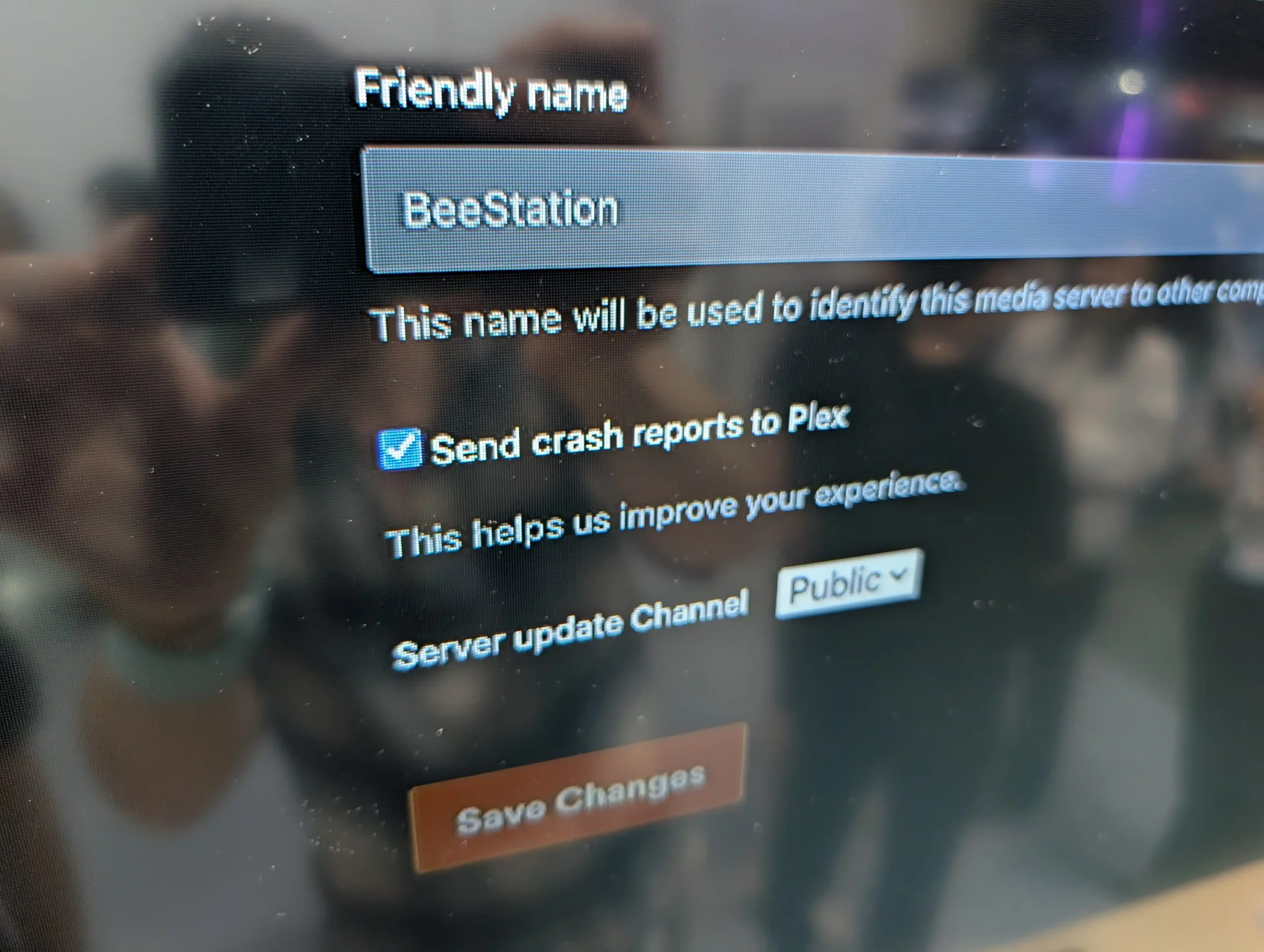
Backup support includes USB-A and USB-C ports, as well as integration with BeeProtect, Synology’s new cloud backup platform. Each BeeStation Plus includes a 3-month free trial of BeeProtect, after which it transitions to a subscription model. While this system offers some of the easiest Plex deployment in Synology’s portfolio, users should be aware of its limitations—chiefly, the lack of RAID protection, upgrade paths storage scalability limits.
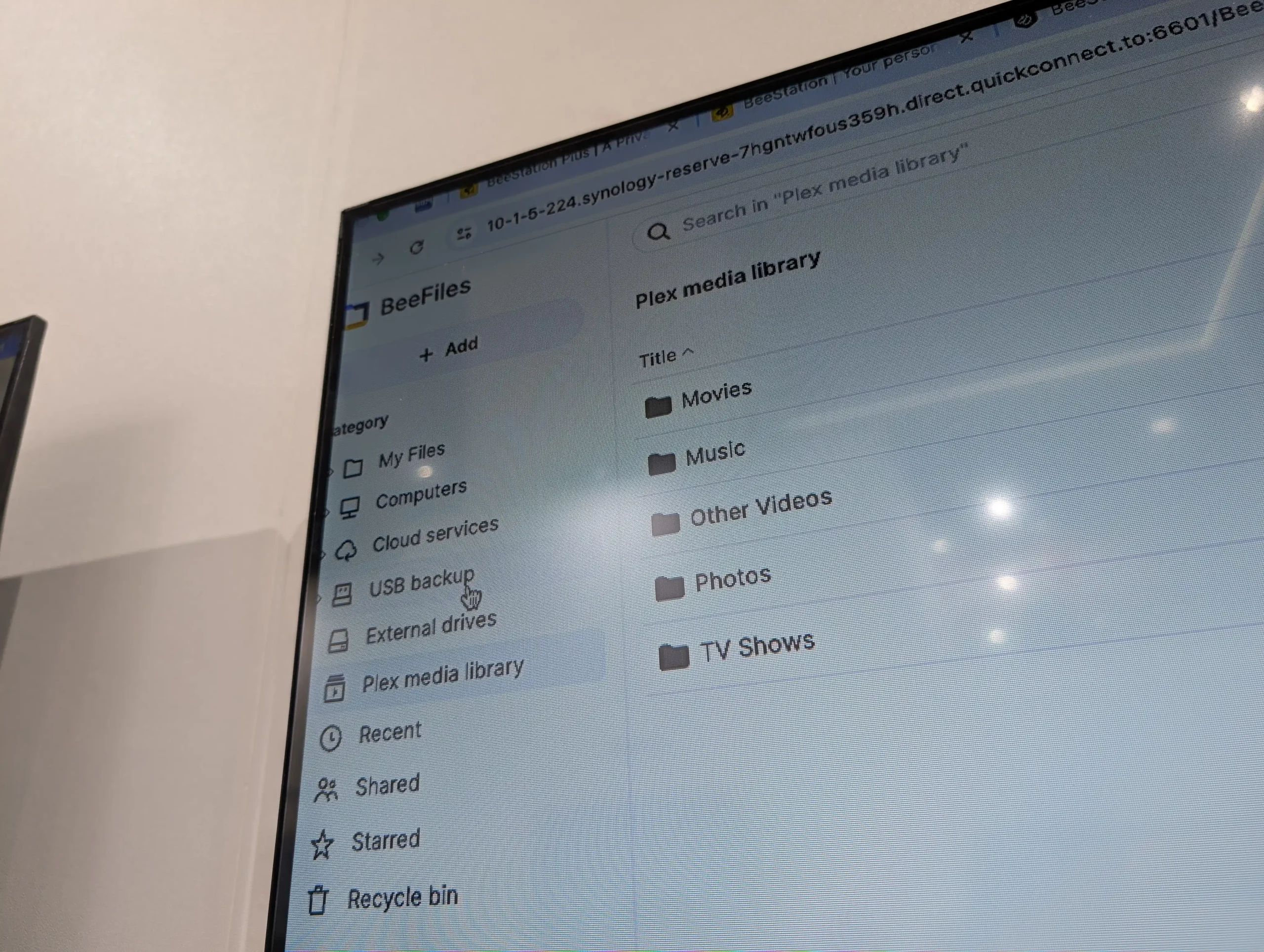
BeeStation Plus Specifications
| Feature | Details |
|---|---|
| Form Factor | Single-bay desktop NAS (sealed) |
| Internal Drive | 1 x 8TB HAT3300 Plus (pre-installed, non-removable) |
| CPU | Intel Celeron J4125 (4 cores, 4 threads) |
| Memory | 8GB (non-ECC) |
| Connectivity | 1x 1GbE, USB-A, USB-C |
| Software | BeeStation Manager, Plex preinstalled, Bee Photos |
| AI Capabilities | Local facial and object recognition |
| Cloud Backup | BeeProtect (3-month trial, subscription thereafter) |
| Media Policy | Synology-verified internal drive only |
| Use Case | Plug-and-play media server, personal cloud, photo archive |
DS225+ – Budget 2-Bay NAS for Entry-Level Users
The DS225+ is Synology’s entry-level 2-bay NAS refresh for 2025, intended for home users, small backups, and basic multimedia needs. It features the same Intel Celeron J4125 processor found in the DS425+ and BeeStation Plus—offering integrated graphics but limited modern performance. Paired with 4GB of DDR4 memory, the system supports two SATA bays, making it suitable for mirrored RAID 1 setups or small independent volumes.
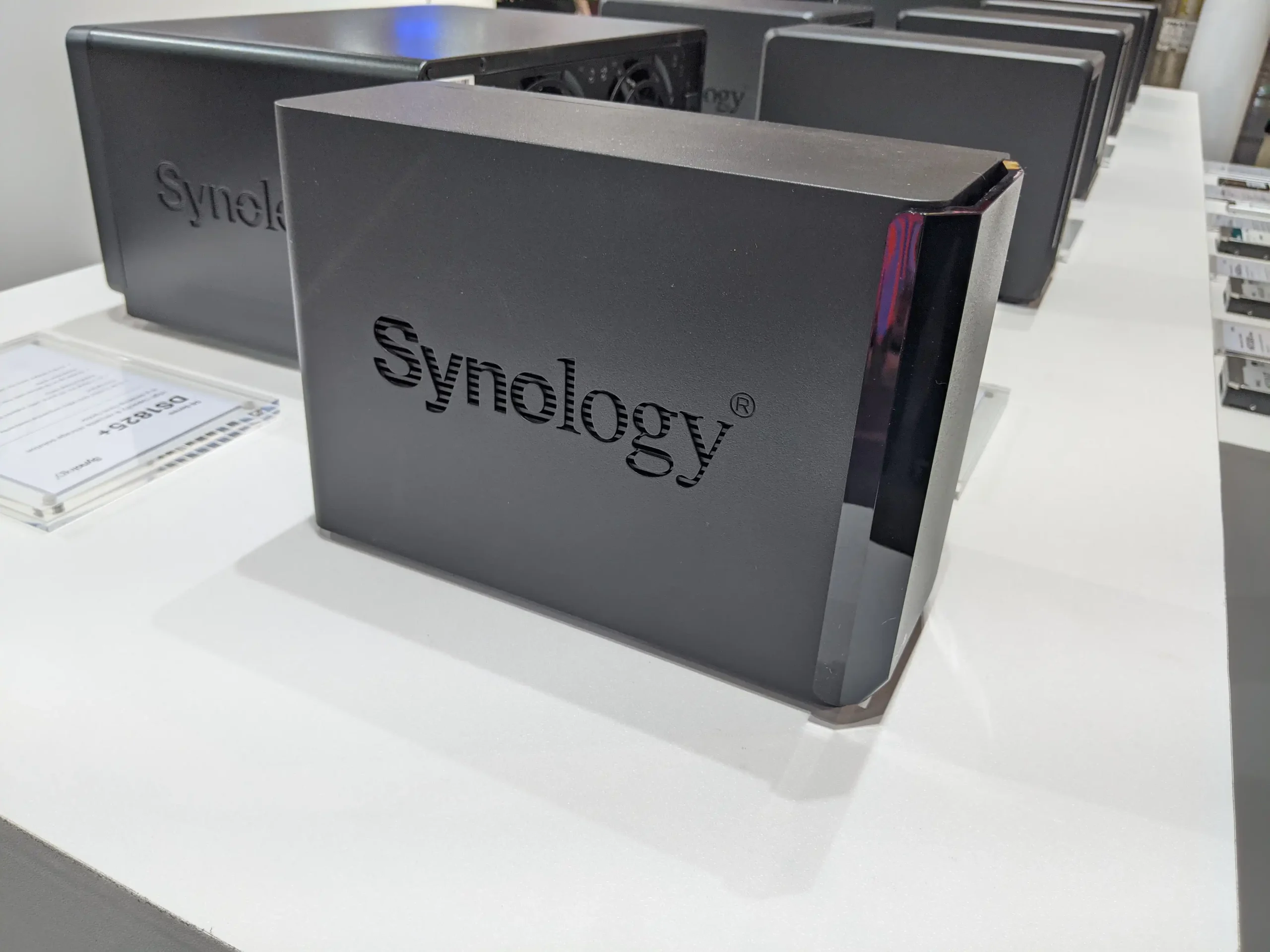
In terms of connectivity, the DS225+ includes 1 x 2.5GbE and 1 x 1GbE Ethernet ports—adequate for most basic workloads, but still a step behind systems offering dual 2.5GbE or upgradable networking. The system lack the two M.2 NVMe slots that can be configured for SSD caching or used as additional storage pools in the DS725+.
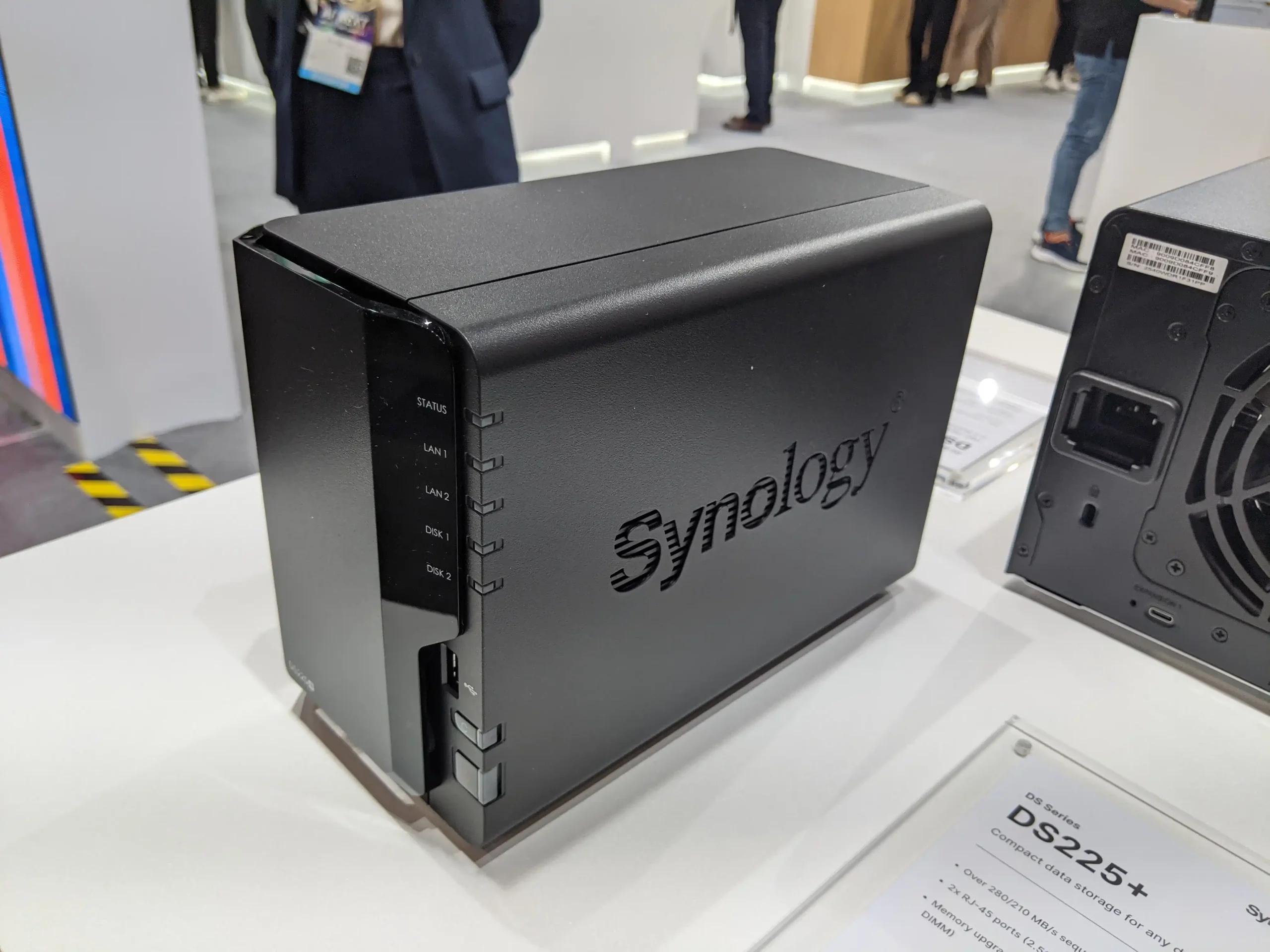
While the DS225+ offers a very approachable route into NAS usage, it is subject to the same Synology-verified storage media policy as the rest of the 2025 series. Users are limited to verified drives for both SATA bays will be especially annying at a device level that is considered very, very ‘entry’, which continues to frustrate those hoping to reuse older hardware or source drives independently.
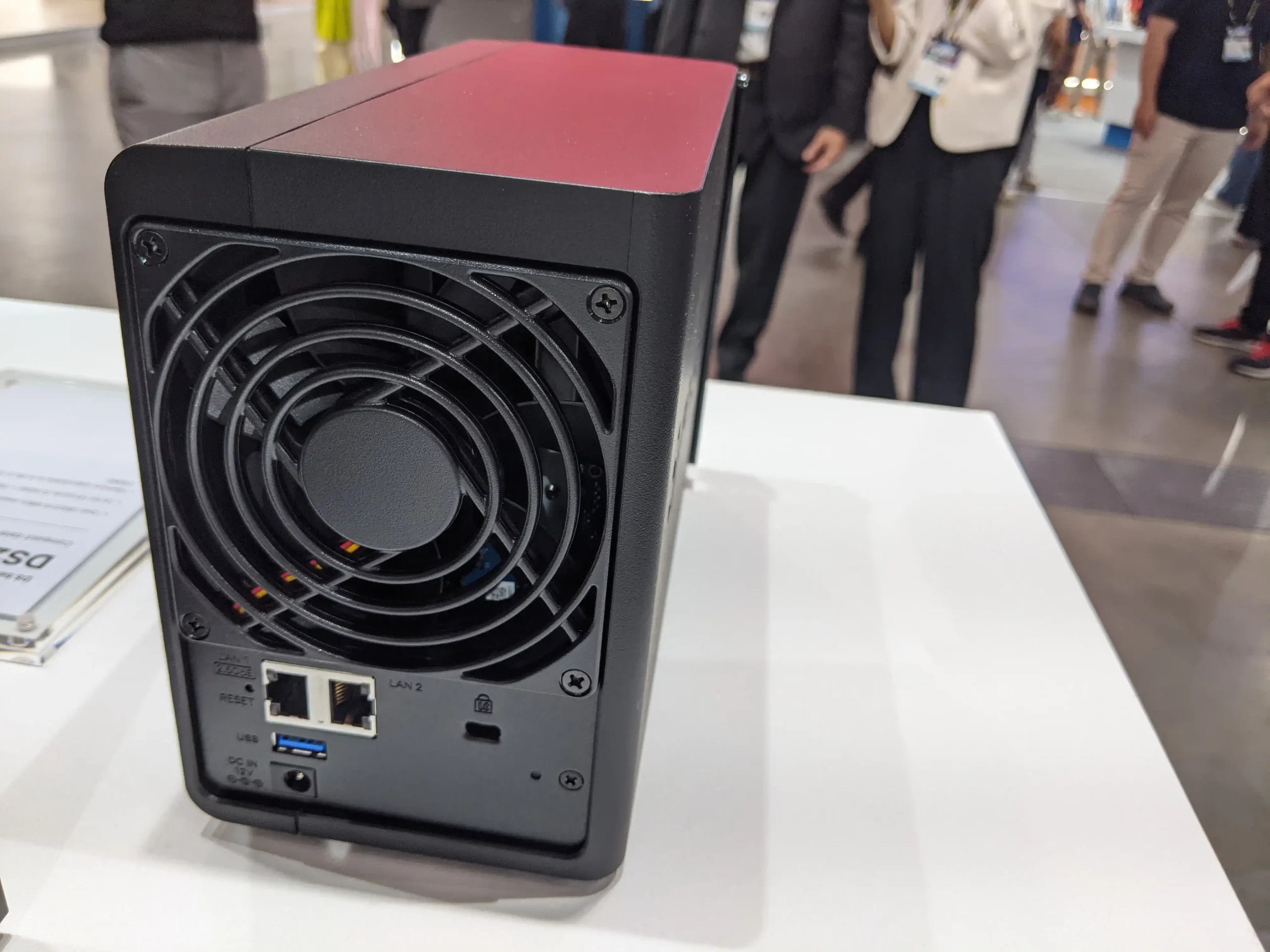
DS225+ Specifications
| Feature | Details |
|---|---|
| CPU | Intel Celeron J4125 (4 cores, 4 threads) |
| Memory | 4GB DDR4 (non-ECC, upgradeability TBD) |
| Drive Bays | 2 x 3.5″/2.5″ SATA |
| Network Ports | 1 x 2.5GbE, 1 x 1GbE |
| Expansion Support | None (no DX support confirmed for this model) |
| PCIe Slot | None |
| Media Compatibility | Synology-verified SATA & NVMe SSDs only |
| Use Case | Home backups, light Plex/media, basic RAID setups |
SPU7200D Series – Synology Enterprise U.3 NVMe SSD for PAS-Series Systems
The SPU7200D Series is Synology’s first enterprise-grade U.3 NVMe SSD, introduced at Computex 2025 to support the new PAS7700 and PAX224 rackmount flash systems. This SSD is designed for mission-critical environments where low latency, sustained throughput, and dual-port failover are essential. It conforms to the U.3 (PCIe 4.0 x4) standard and operates as a dual-port SSD, ensuring continuous accessibility in active-active dual-controller setups like those used in Synology’s PAS architecture.
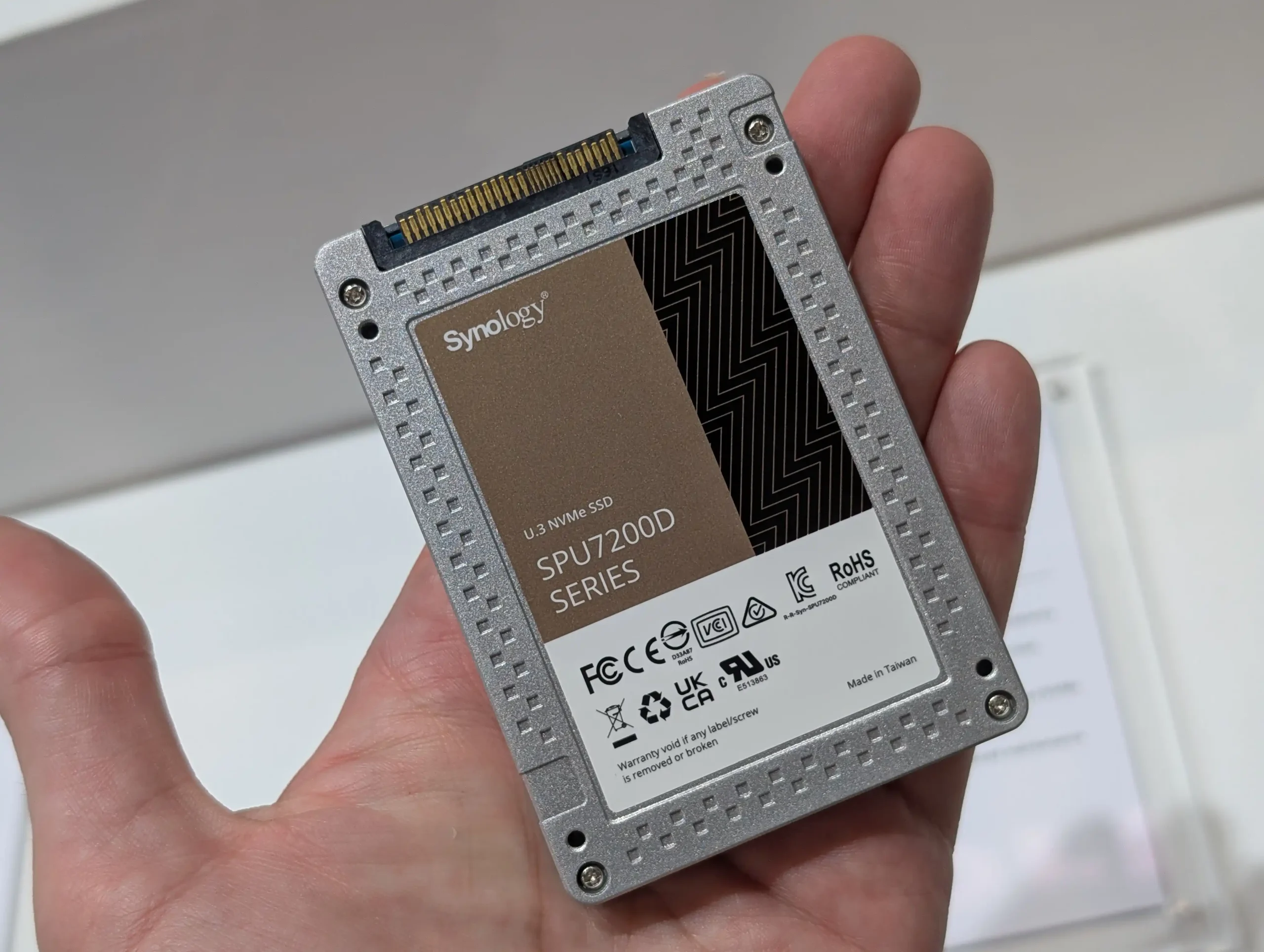
Performance characteristics of the SPU7200D include up to 140,000 100% 4K random write IOPS, with a design focus on low-latency access patterns for high-concurrency workloads. The drive includes support for TCG Opal encryption, crypto erase, and anti-PSD (power safe data) protections to ensure fast and secure data sanitization in compliance-driven environments.
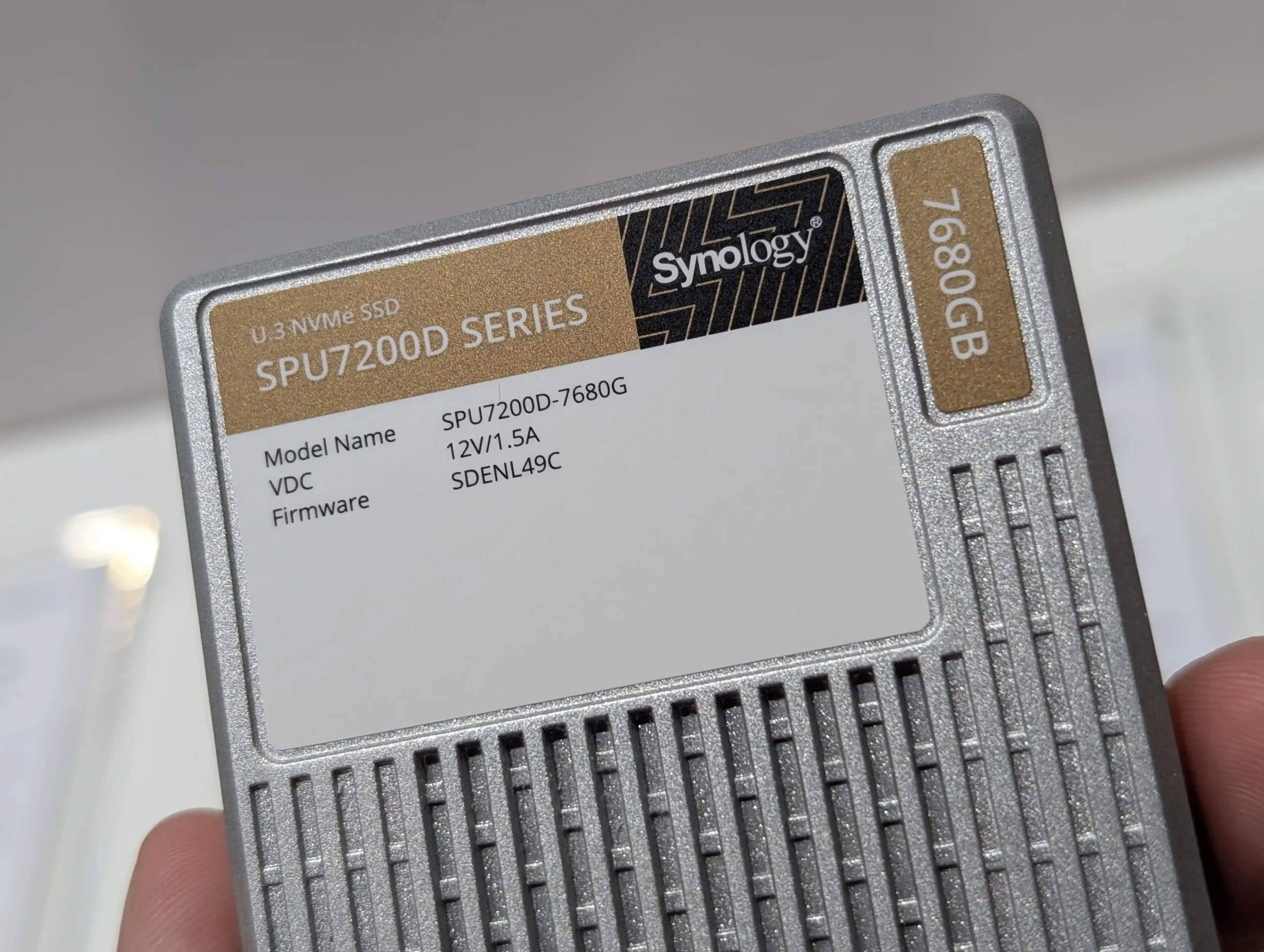
It also supports in-system firmware upgrades through Synology DSM, reducing maintenance windows during firmware validation or patch rollouts. As part of Synology’s locked ecosystem, the SPU7200D is required in PAS systems under the Synology-verified storage media policy—a continuing point of contention for enterprise users seeking broader SSD sourcing options.
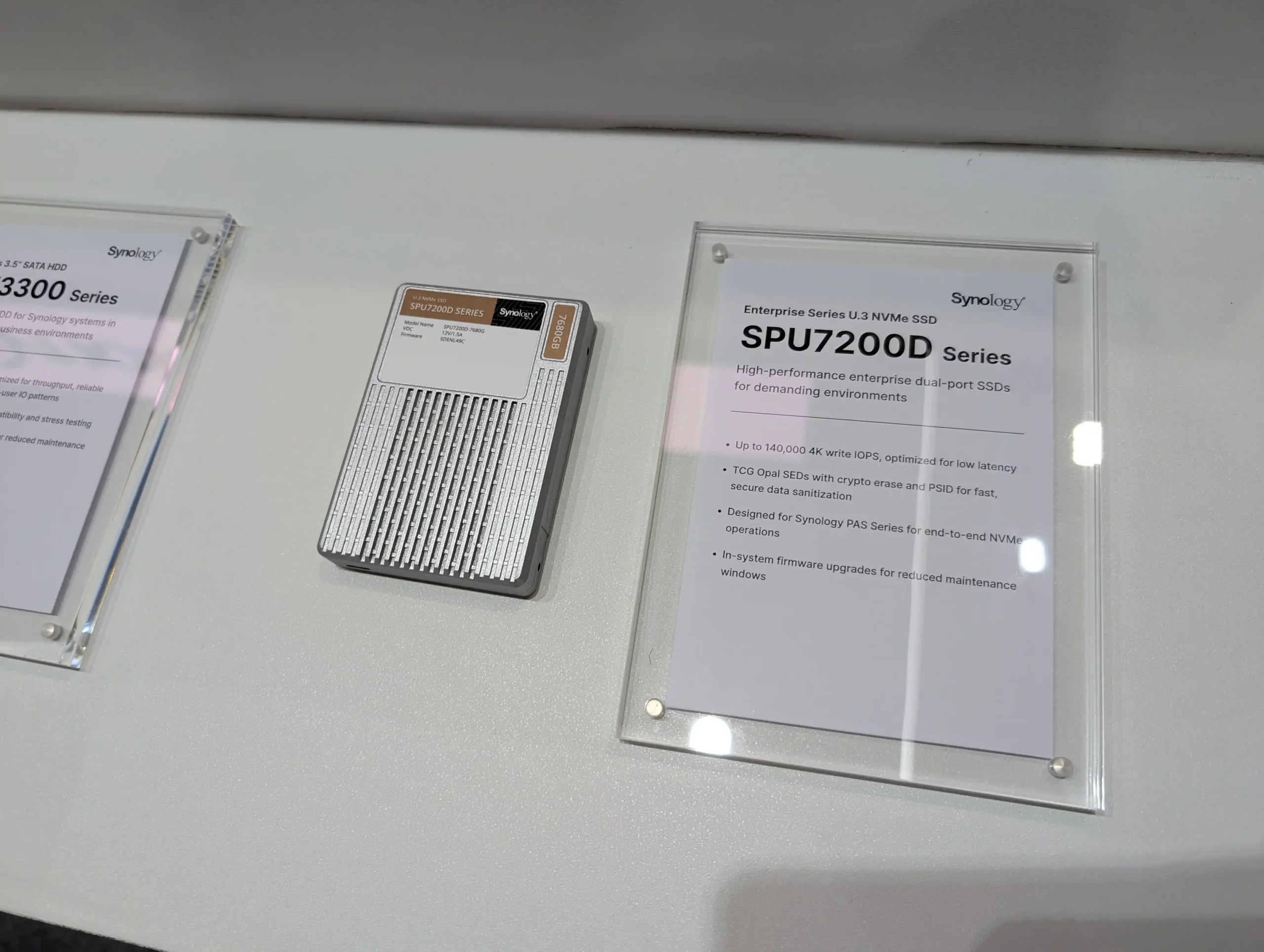
SPU7200D U.3 NVMe SSD Specifications
| Feature | Details |
|---|---|
| Form Factor | U.3 NVMe (2.5″, PCIe 4.0 x4) |
| Ports | Dual-port enterprise SSD |
| Max 4K Write IOPS (100%) | Up to 140,000 |
| Latency Optimization | Yes – Low latency under mixed and write-heavy workloads |
| Security Features | TCG Opal, crypto erase, anti-PSD |
| Firmware Management | In-system firmware upgrades via DSM |
| Media Policy | Synology-verified only (required in PAS-series) |
| Use Case | Enterprise flash arrays, PAS7700, high-concurrency VM use |
📧 SUBSCRIBE TO OUR NEWSLETTER 🔔
🔒 Join Inner Circle
Get an alert every time something gets added to this specific article!
This description contains links to Amazon. These links will take you to some of the products mentioned in today's content. As an Amazon Associate, I earn from qualifying purchases. Visit the NASCompares Deal Finder to find the best place to buy this device in your region, based on Service, Support and Reputation - Just Search for your NAS Drive in the Box Below
Need Advice on Data Storage from an Expert?
Finally, for free advice about your setup, just leave a message in the comments below here at NASCompares.com and we will get back to you. Need Help?
Where possible (and where appropriate) please provide as much information about your requirements, as then I can arrange the best answer and solution to your needs. Do not worry about your e-mail address being required, it will NOT be used in a mailing list and will NOT be used in any way other than to respond to your enquiry.
Need Help?
Where possible (and where appropriate) please provide as much information about your requirements, as then I can arrange the best answer and solution to your needs. Do not worry about your e-mail address being required, it will NOT be used in a mailing list and will NOT be used in any way other than to respond to your enquiry.

|
 |
| Where to Buy a Product | |||
|
|
    
|

|
VISIT RETAILER ➤ |
 |
    
|

|
VISIT RETAILER ➤ |
 |
    
|

|
VISIT RETAILER ➤ |
 |
    
|

|
VISIT RETAILER ➤ |
We use affiliate links on the blog allowing NAScompares information and advice service to be free of charge to you. Anything you purchase on the day you click on our links will generate a small commission which is used to run the website. Here is a link for Amazon and B&H. You can also get me a ☕ Ko-fi or old school Paypal. Thanks! To find out more about how to support this advice service check HERE If you need to fix or configure a NAS, check Fiver Have you thought about helping others with your knowledge? Find Instructions Here
Terramaster TOS 7 Preview - Next Gen NAS Ready?
What is QNAP Planning for 2026? Round Up of the QNAP 2025/2026 Event in London
2x 10GbE to USB4 Adapter - DO YOU NEED THIS?
New Gl.iNet Beryl 7, Comet 5G SIM KVM and Flint 3e Value Router Revealed
NEW UGREEN DXP4800 PRO and DXP4800S NAS REVEALED
NanoKVM Pro Review - SO, SO CLOSE TO PERFECT...
Access content via Patreon or KO-FI
Discover more from NAS Compares
Subscribe to get the latest posts sent to your email.


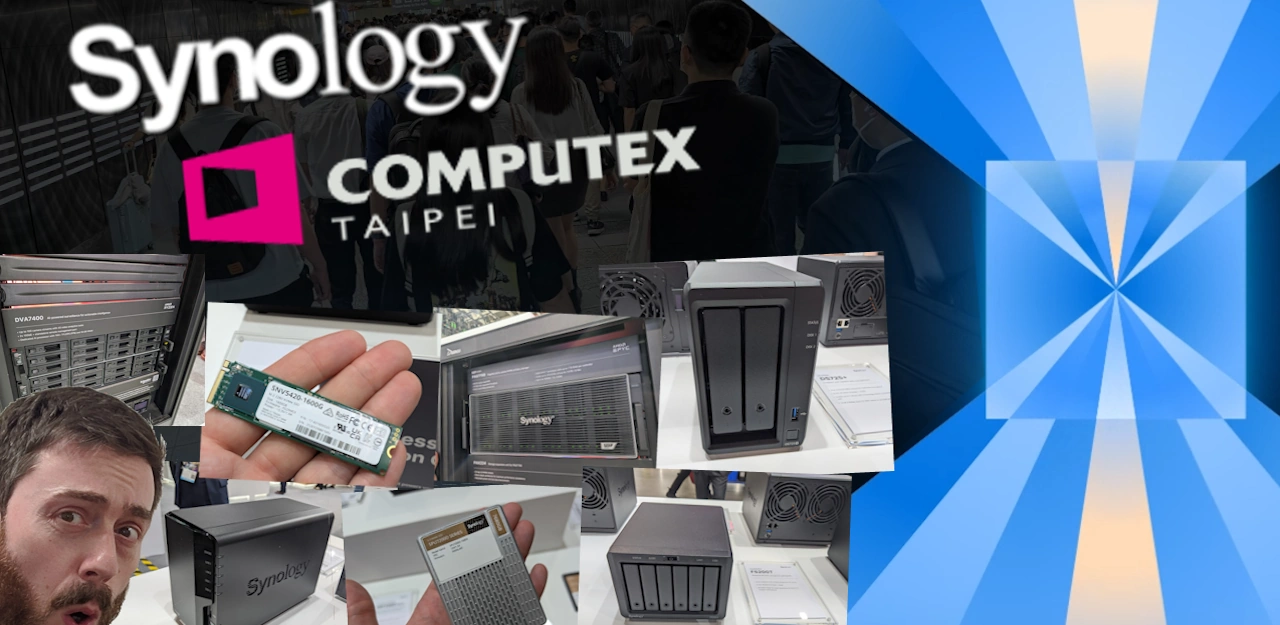



Thank you, very cool!
REPLY ON YOUTUBE
I know this is 1 year old now. But how is it after they removed the compression codecs?
REPLY ON YOUTUBE
I cannot find the Smart Time Lapse on my NAS drive. It seems to be a mystery feature that I can’t locate. Should it be on all drives or is it only on the high-end models?
REPLY ON YOUTUBE
is the camera type must be Synology Brand too?
REPLY ON YOUTUBE
Have you managed to add a remote camera to your NAS via RTMP?
Congratulations on the video.
REPLY ON YOUTUBE
Any tests/review of alert/notification on mobile device (where mobile is on a different network and turned off). That is the most important feature to me. What use from having video of masked men taking the goods away.
REPLY ON YOUTUBE
They do charge with camera licensing, It is extortionary!
REPLY ON YOUTUBE
How do you use the Smart Search in the monitoring center? I see the separate application but the search icon isn’t available like in your video. Do i have to turn it on somewhere?
REPLY ON YOUTUBE
synology all the way , thankyou for sharing
REPLY ON YOUTUBE
Brilliant.. Can these feed be seen on an Android TV? Does that need any additional settings?
REPLY ON YOUTUBE
How does this compare to Blue Iris?
REPLY ON YOUTUBE
Thank you so much for the details
REPLY ON YOUTUBE
Thanks for detailed review!
REPLY ON YOUTUBE
DS923+ that I just bought. partially for cameras…
REPLY ON YOUTUBE
From a performance perspective the desktop app is way better than the web interface.. Can’t stand using the web interface once using that.
REPLY ON YOUTUBE
If for not the license cost I would probably buy this. Make it $10 and okay. At $50, hard pass, that is half the cost of a camera.
REPLY ON YOUTUBE
Thank you for all you do! I have learned so much about Synology, NAS, Surveillance Station, RAID configuration, etc. Currently I have two Synology NAS set up on two different sites, home and a commercial building I manage. Router/switches Unifi system in both locations. For the remote location, I opted for the DVA3221, based on my research and your excellent explanation of the capacity, and the fact that it is a pretty significant deployment. I figure about 25 remote cameras where complete.
What I have found over time is that you start to disregard the notifications when there are so many, which obviously defeats the purpose. With the better analytics, I can be aware of, and more tuned into, things that are issues or threats. For example there are several tenants, but for example I only need to know if an unknown character enters various areas.
What I found in setting up the systems was struggling with CMS or Central Management System. I was easily able to deploy CMS, which allowed me to monitor and configure the basic settings of the remote NAS. However, what I struggled with was remotely dealing with Surveillance Station and adding remote cameras into the monitoring center . It took a call to Synology to realize that there is a separate “CMS” app, specific for SS and even Synology support admitted that the documentation is pretty limited.
I think as multi-site deployment is likely becoming even more prevalent with home users, it may be a great video for you to consider. I am sure others would be interested in this and are searching for more detailed information.
Aside from the actual CMS setup, I still struggle with what is the best configuration for secure and quick connections. Although I am still working through the deployment, getting the cameras to all work over HTTPS and now getting DS Cam to also connect over HTTPS is giving me some headaches. A true complete setup for remote surveillance, with the CMS issues and best connection methods (VPN, Quick Connect?) would be so helpful as even when you get it working there is the lingering concern as to how exposed your setup may be.
Thank you again for all your effort and happy to see your subscriber list growing!
REPLY ON YOUTUBE
How many cam license do you have, that extreme expensive
REPLY ON YOUTUBE
Any way to get a feed to output through my home network to a smart TV on the same network? Would only be a single feed with no need to use a cursor on the screen.
REPLY ON YOUTUBE
loving it so far, trying to get the PTZ patrol mode to work with my reolink. was hoping you would touch on this feature. also how to get speakers to work lol
REPLY ON YOUTUBE
Robbie you have earned a NAS PhD the hard-way by earn it.
Oh, I found a guy that’s almost as smart as you are 😉
Eddie’s DIGIBITE https://www.youtube.com/@DIGIBITE/videos
REPLY ON YOUTUBE
I’m running a DVA 3221 at one customer site with 6 cameras at 4K, 1 at 4 MP, and multiple AI analytics (car counting, LPR, facial recognition, intrusion line crossing), and it works like a champ. On the other hand, I have seen some inconsistencies with a DVA 1622 deployed at another customer site that only has three cameras running, and only two LPR tasks (Entry and Exit) on two cameras. The vehicle are detected fine, but the license plates are not consistently captured like with the more powerful DVA 3221.
REPLY ON YOUTUBE
This is an awsome video for an equally awesome software from Synology. Thank you!
REPLY ON YOUTUBE
This screams SMART system so is this something that can be done using a home network that is offline? If it requires to be connected to the grid then it’s a downgrade from the old software.
REPLY ON YOUTUBE
Does it have an android and ios app?
REPLY ON YOUTUBE
Outstanding video, very useful overview and tips, thank you!
REPLY ON YOUTUBE
Thanks for this video! I just want to know if you can still use it as a regular NAS if you’re using it as a surveilance station? I’m looking to use it as both NAS and NVR.
Thank you!
REPLY ON YOUTUBE
thankyou how about the qnap that we can use coral?
REPLY ON YOUTUBE
I’ld like to see a comparison between surveillance station & blue iris.
REPLY ON YOUTUBE
I really miss being able to set a high speed for playback, then click “next” after each clip, to quickly review all my security recordings in one go. With 9.x I have to change the speed on each clip. RIP my favorite 8.x feature.
REPLY ON YOUTUBE
Just say ‘use’ rather than ‘utilise’! Sorry, was just driving me to distraction form otherwise great vids
REPLY ON YOUTUBE
Hi, what camera’s are you using / suggest. Could you do a video on these. Thanks
REPLY ON YOUTUBE
Serious question is it worth hammering and shortning the life of the drives on a ‘home nas’ (likely only gets use a few hours a day) 24/7 over using a dedicated NVR?
REPLY ON YOUTUBE
I used Synology Surveillance Station Time Lapse to compress 24 hours into 2 minutes to highlight the different styles of night vision. It’s just one of the great features!
https://youtu.be/I3UZdiklNhk
REPLY ON YOUTUBE
I am very interested in what BC500 functions change on a basic Synology DS918+/20+/23+, etc without the DVA model. Like the facial recognition?????
REPLY ON YOUTUBE
If it wasn’t for Surveillance station I’d probably switched to TrueNAS. But Synology really did an amazing job on this.
So happy with my DS1621+ (and DS916+ for backups).
REPLY ON YOUTUBE
Hello, we had a fire in our server room which affected our NAS too. Synology team says Motherboard is damaged & they shown us the same.
Now my question is should I buy the New NAS or go for second hand? However my purpose is to just have that for Backup only. Which I’ll be taking only once in a day.
Synology Nas 1821+ – 6 Bay
And should I buy 6 Bay again or 2 or 4 bay is okay?
I’m from India & I don’t know if buying from eBay is good option.
REPLY ON YOUTUBE